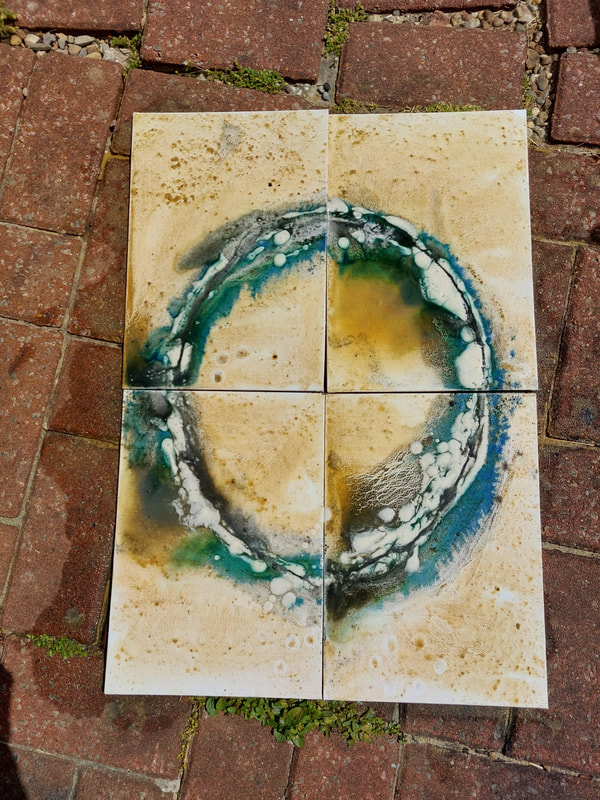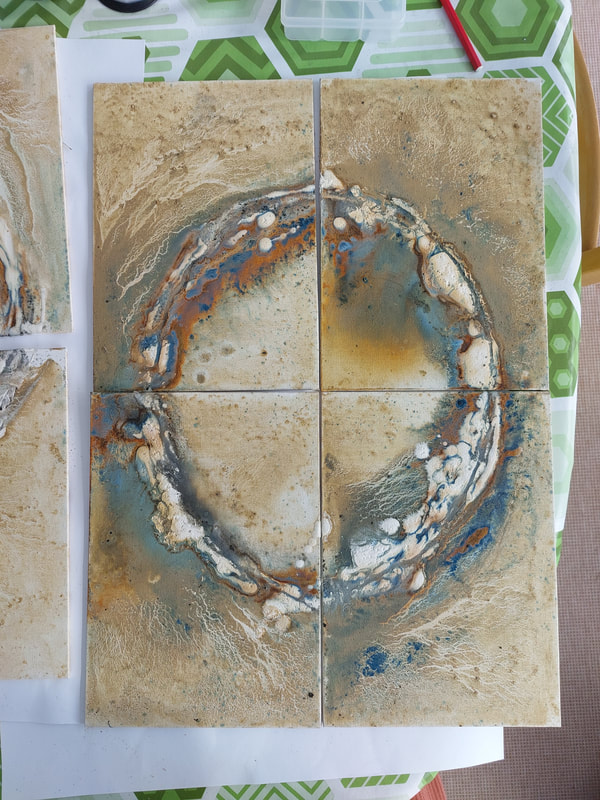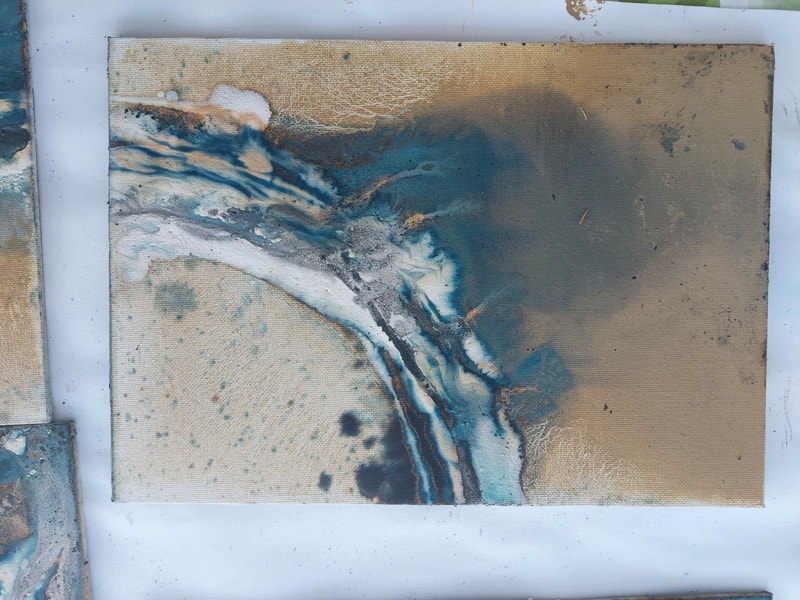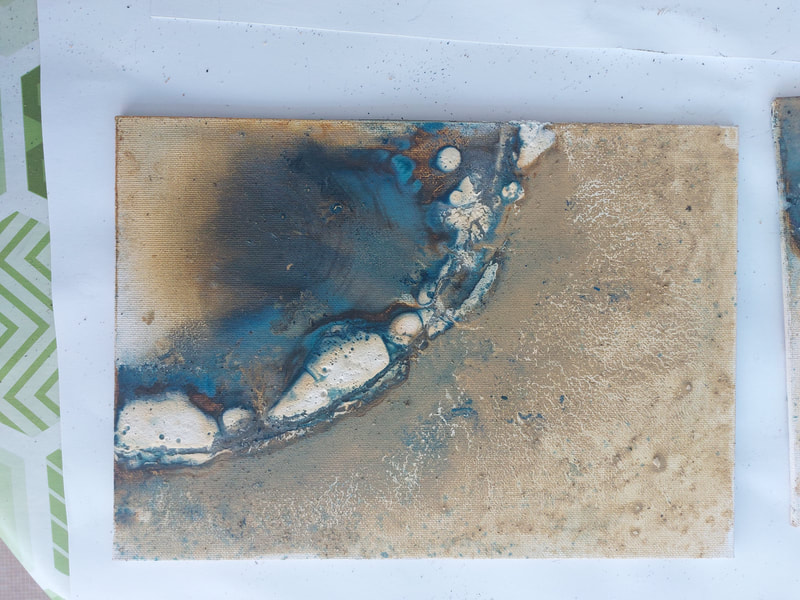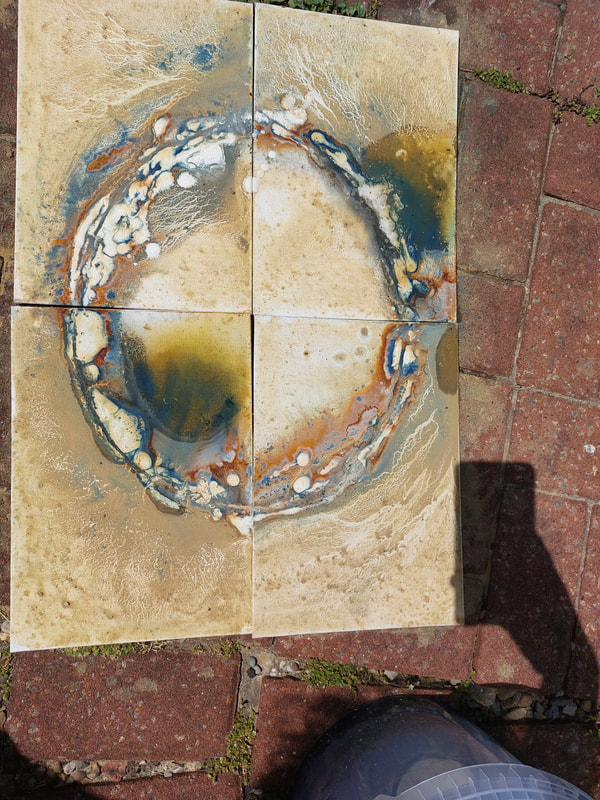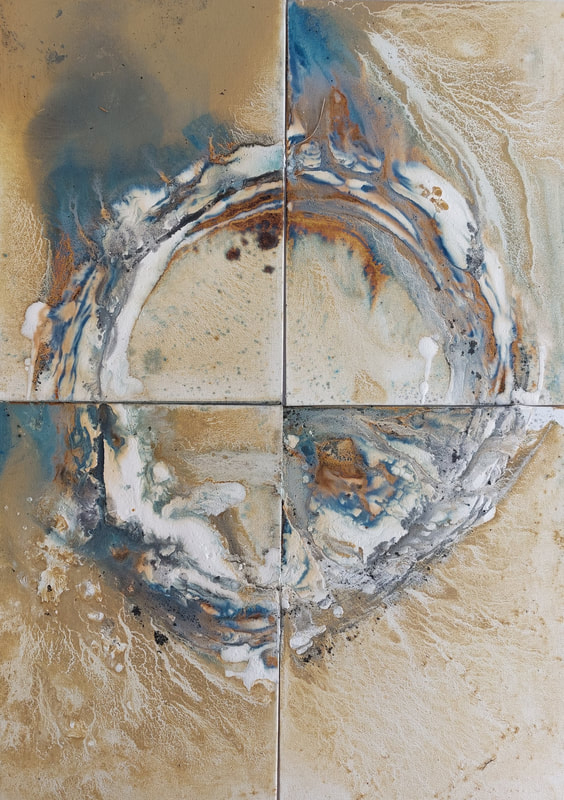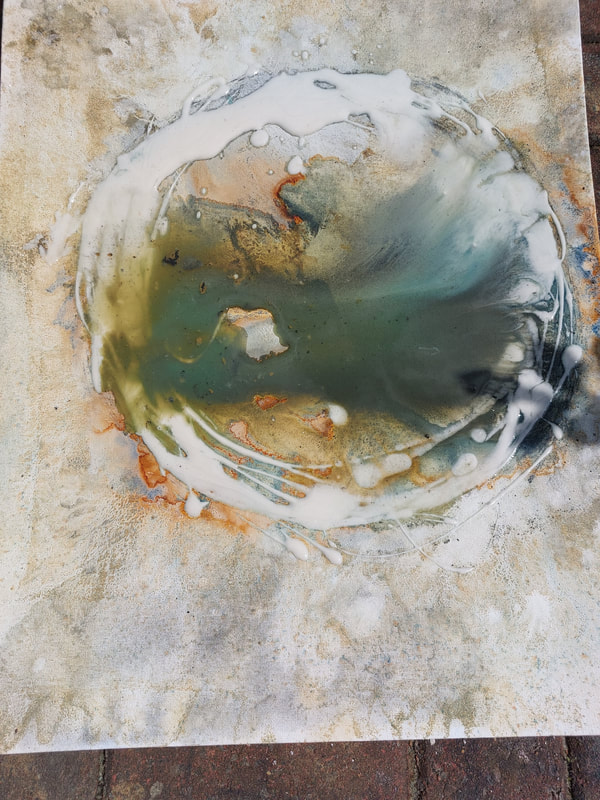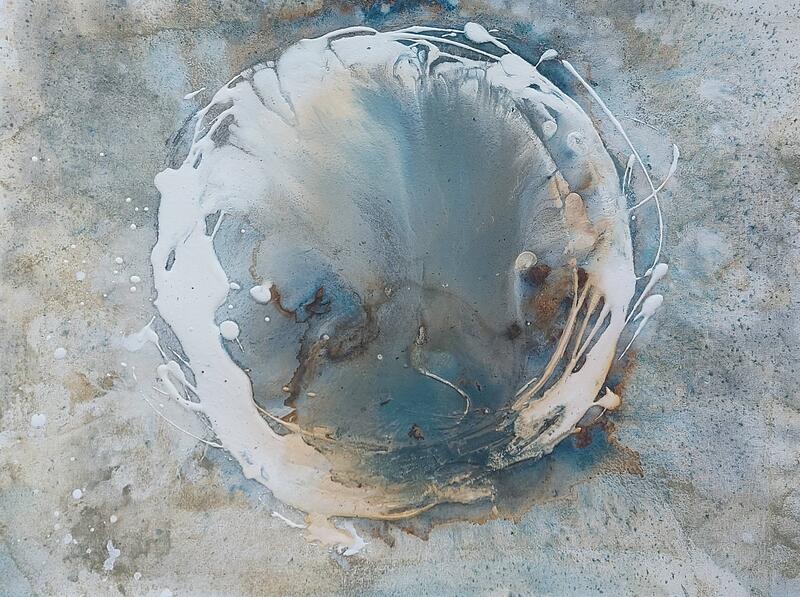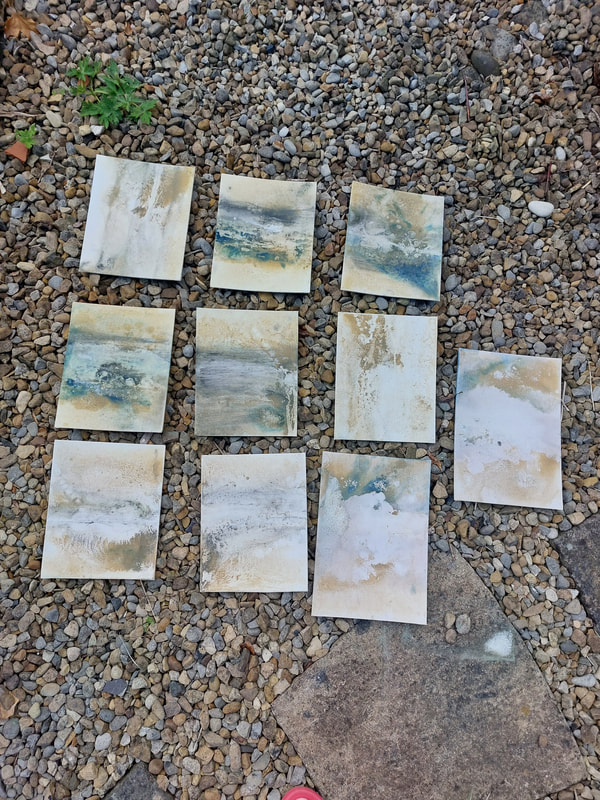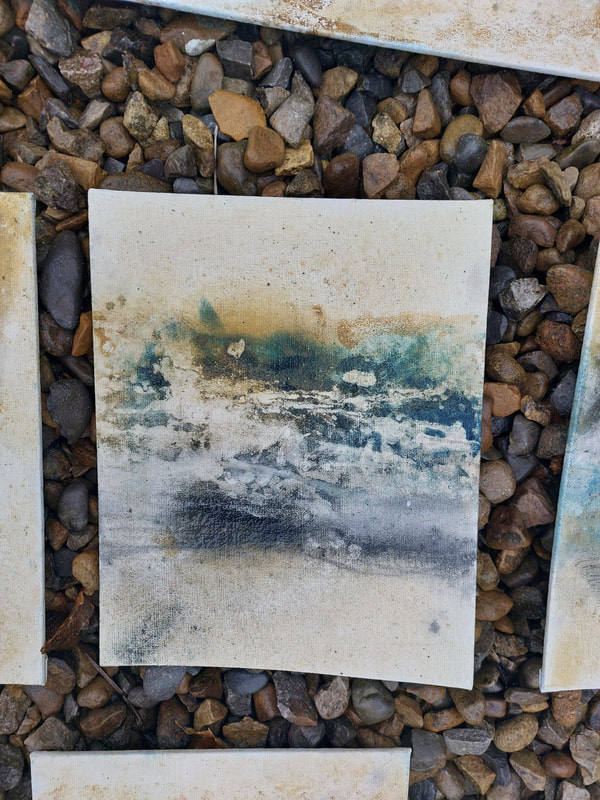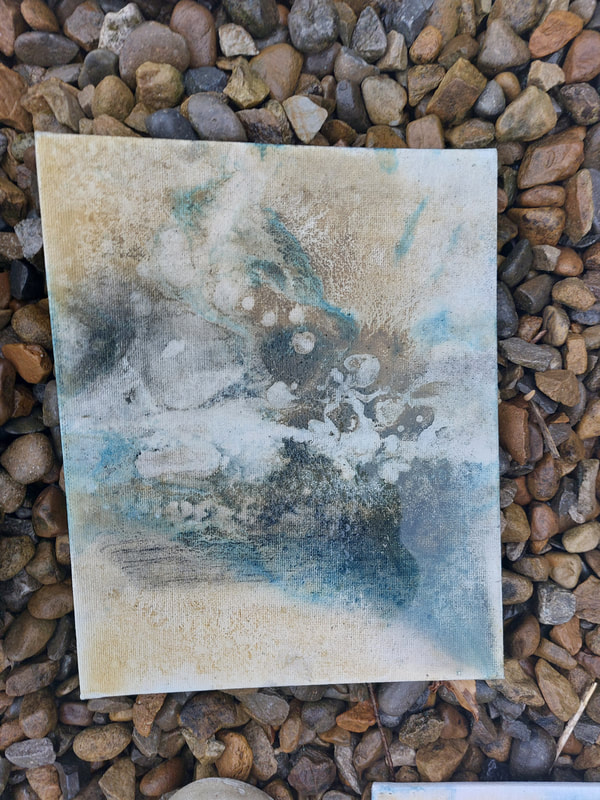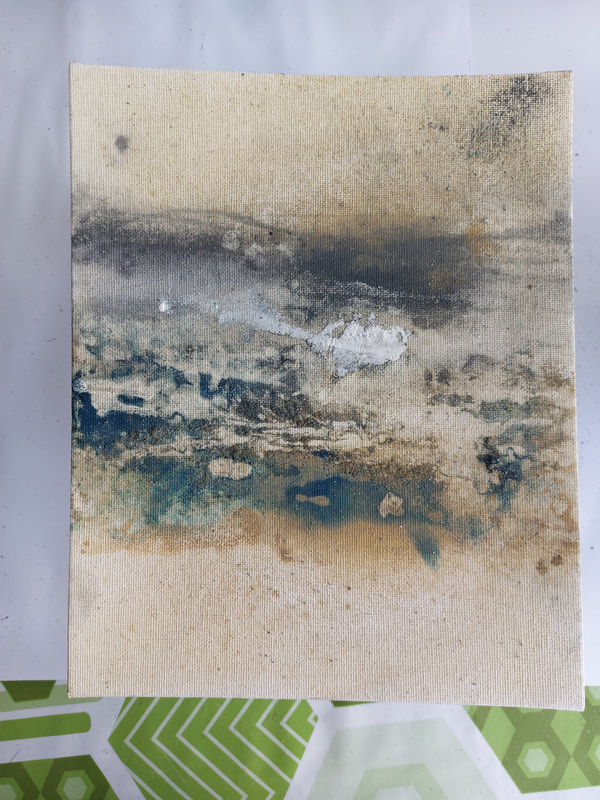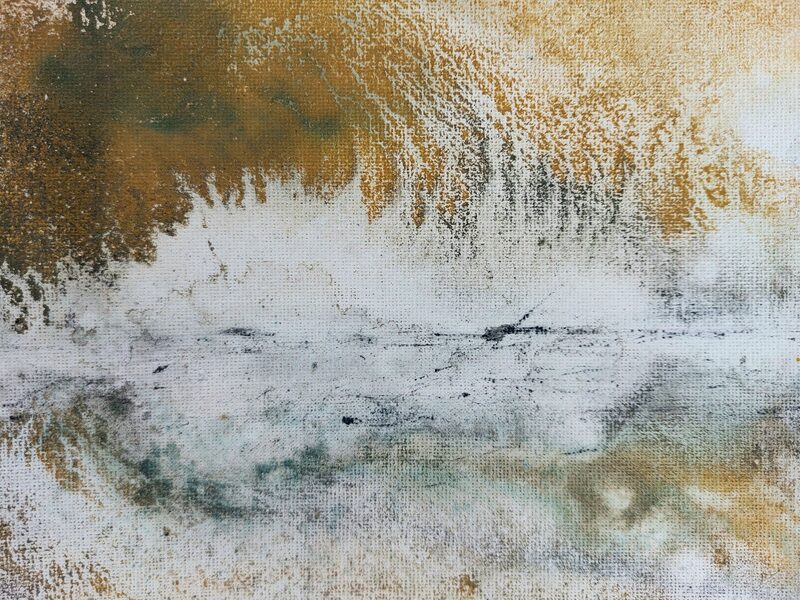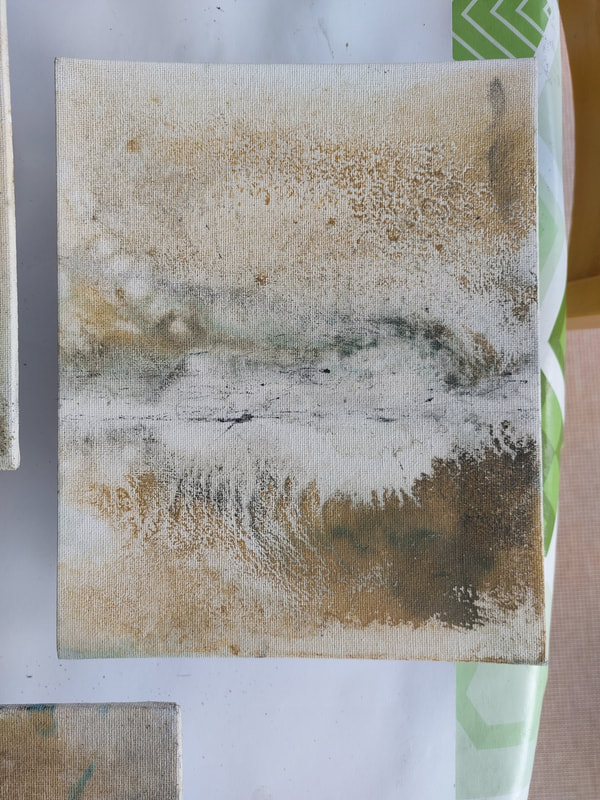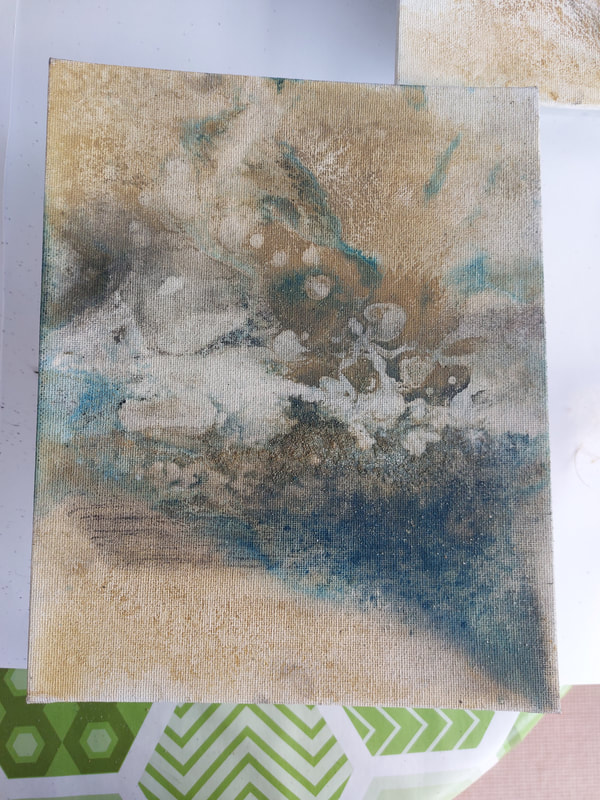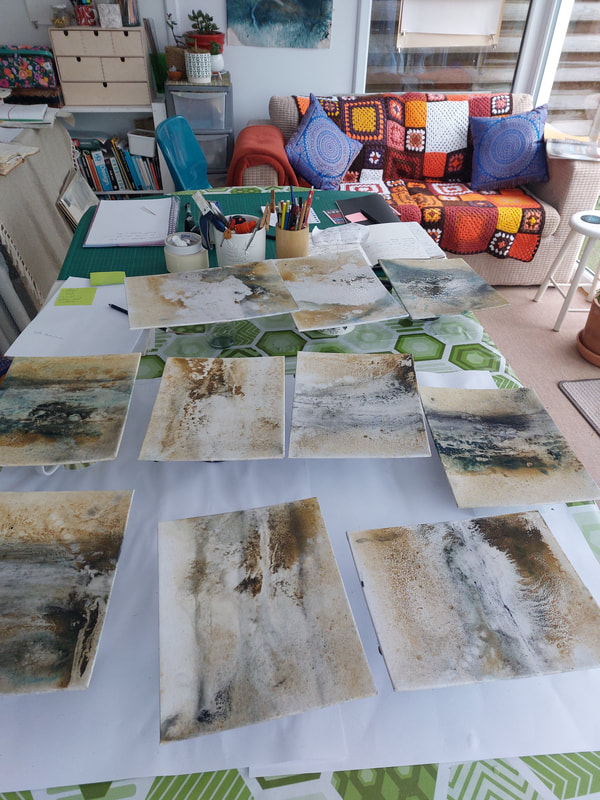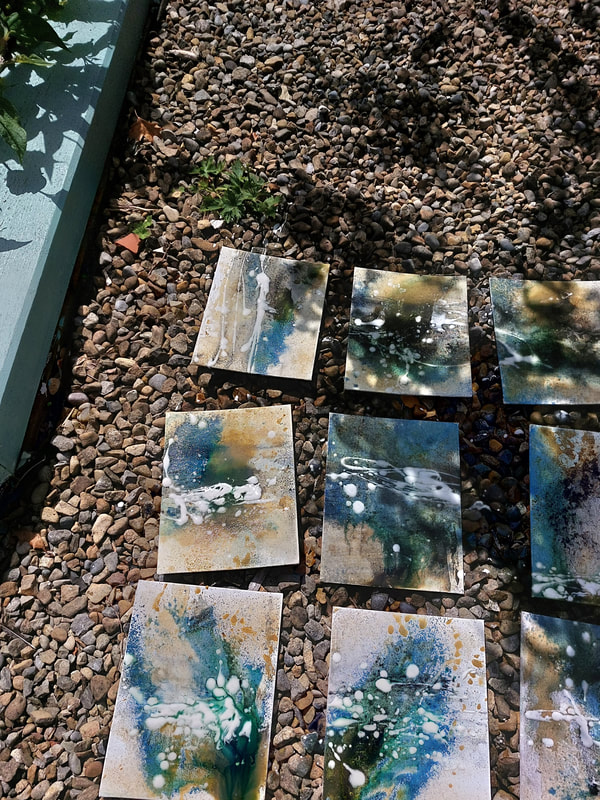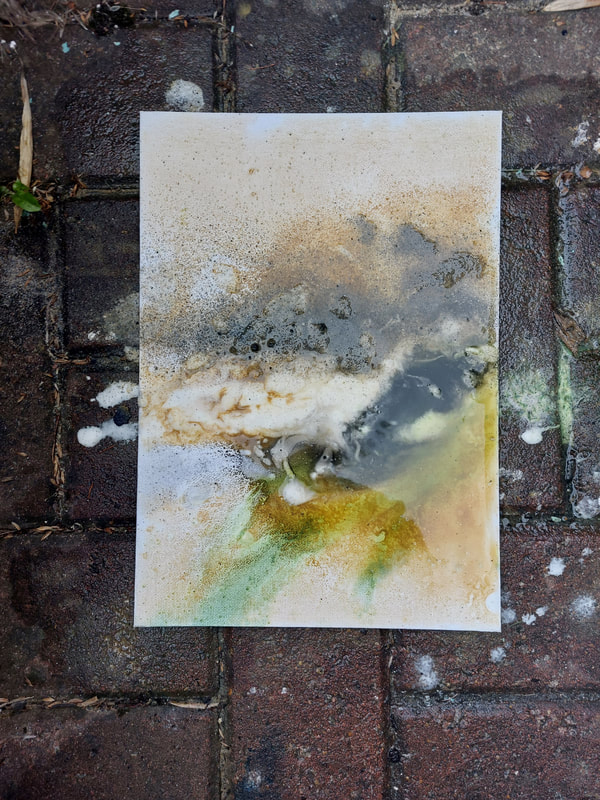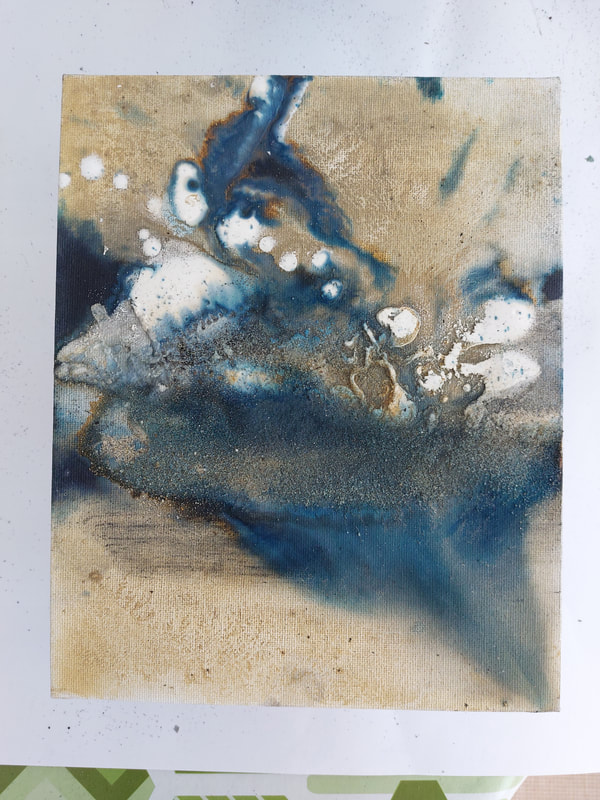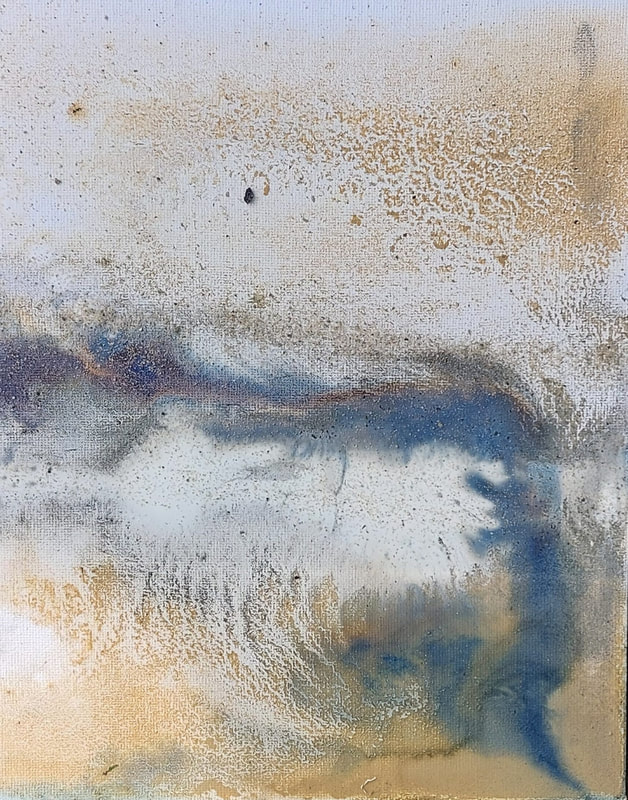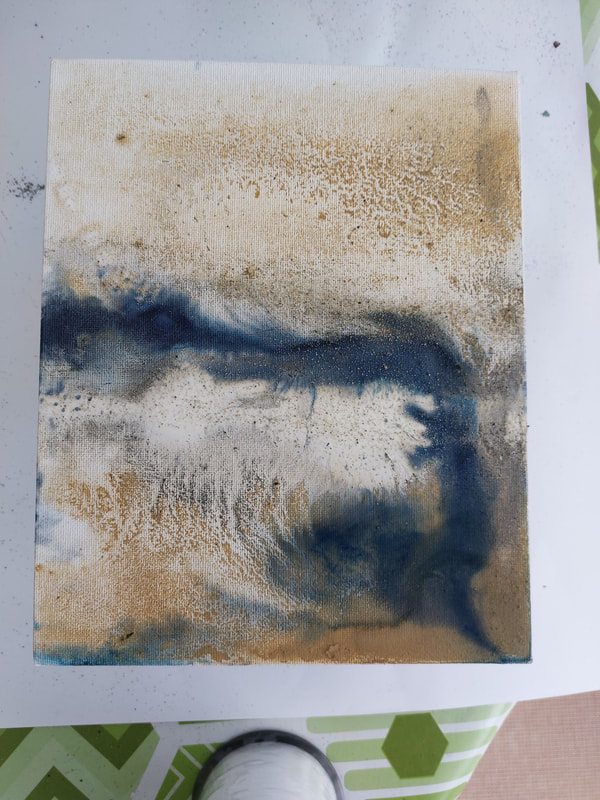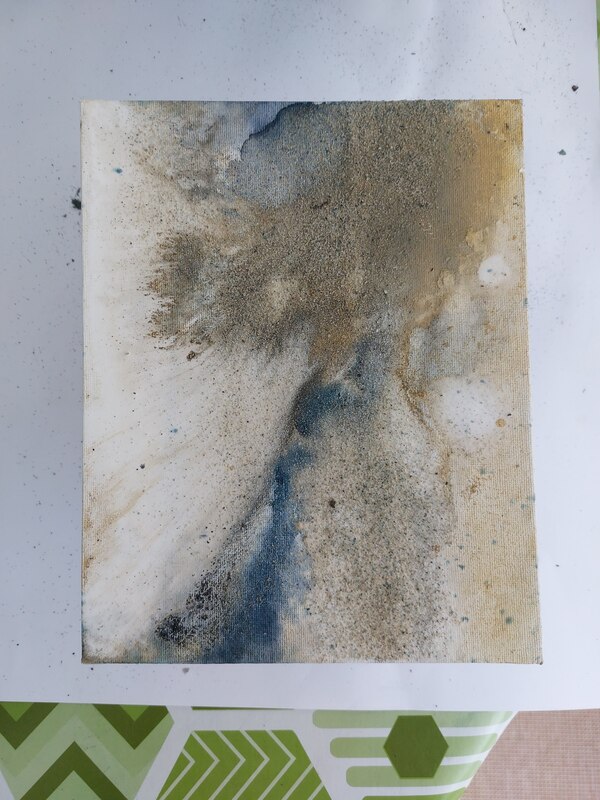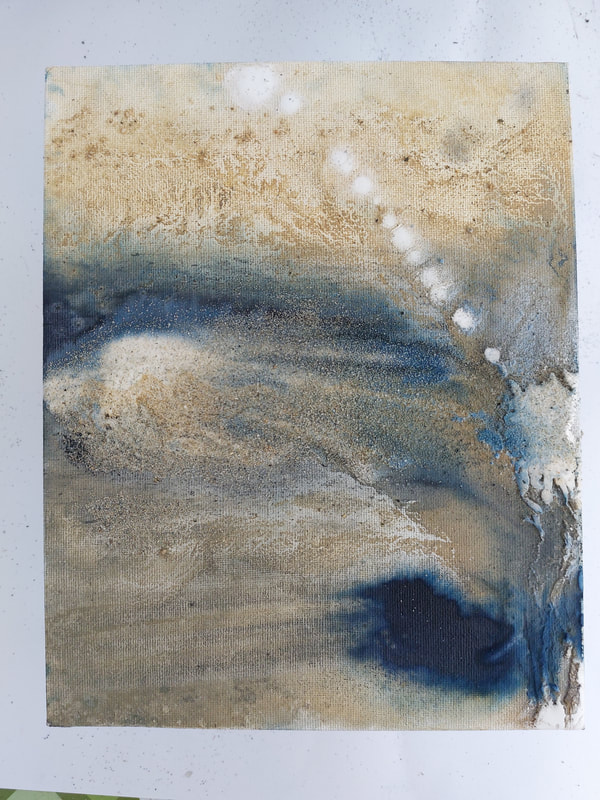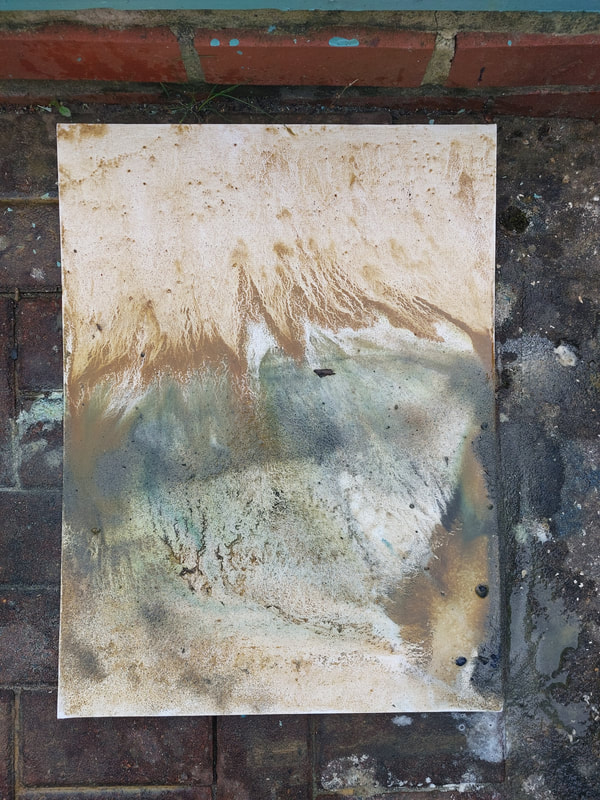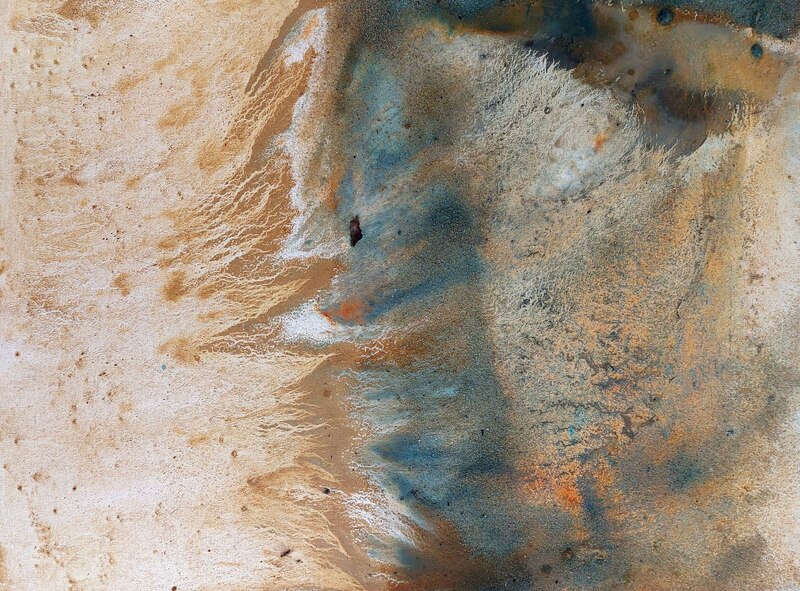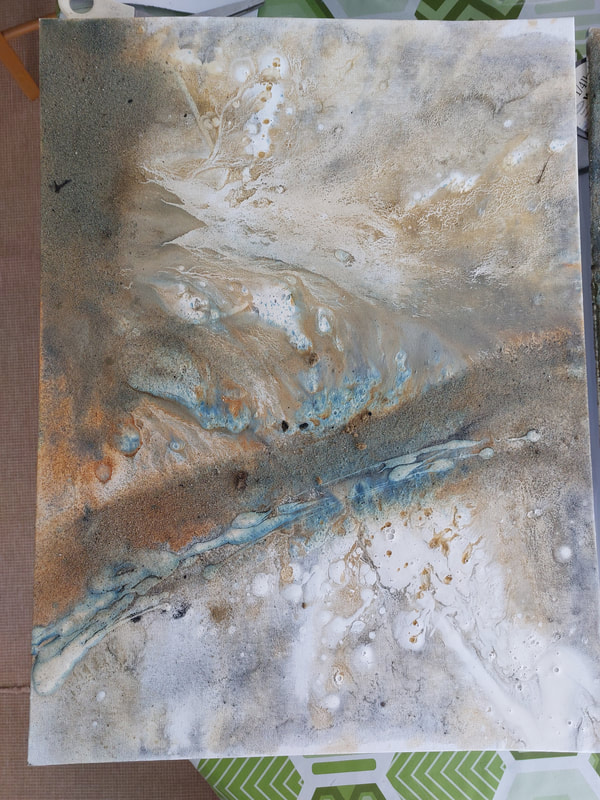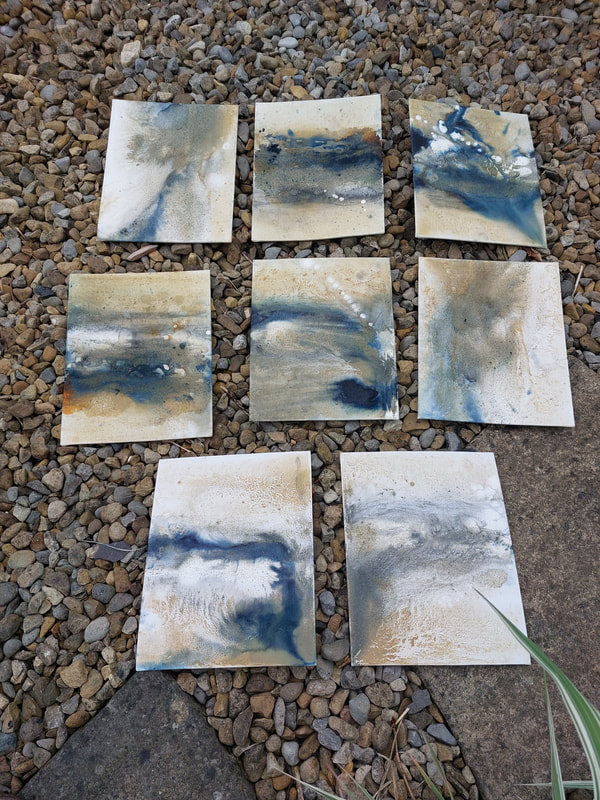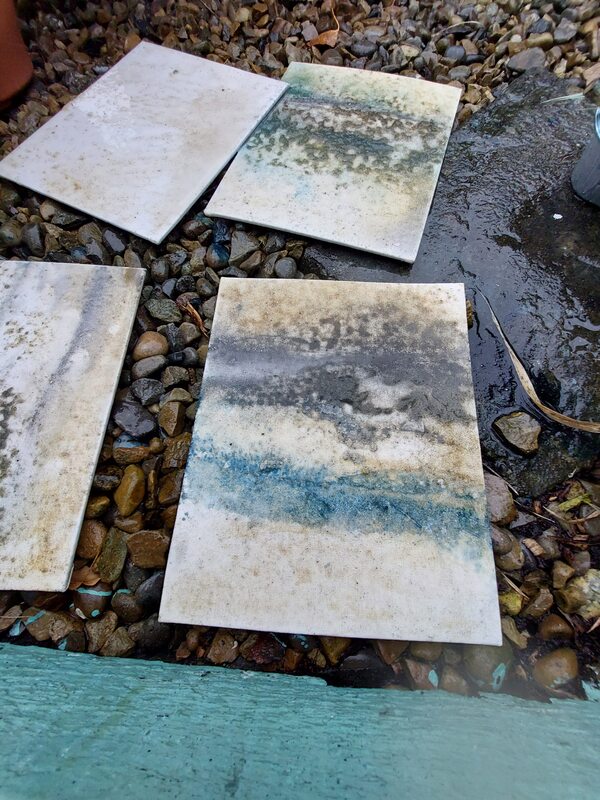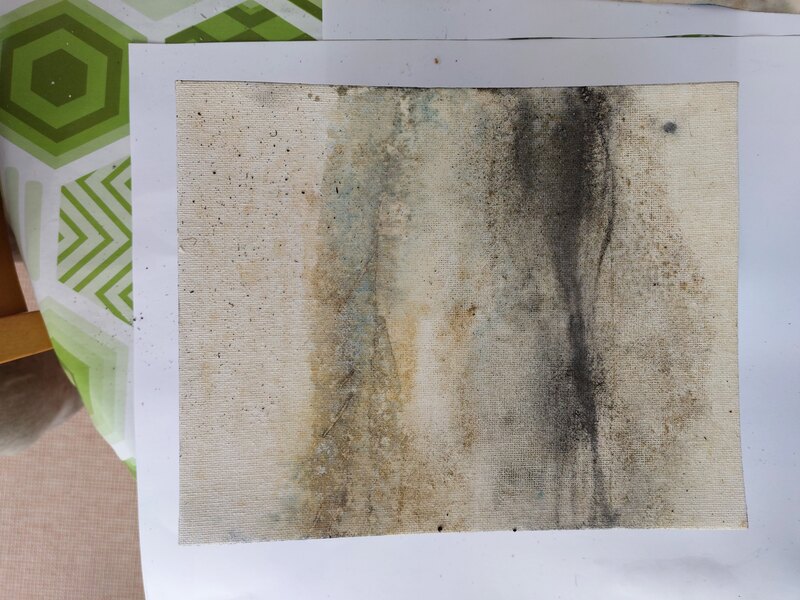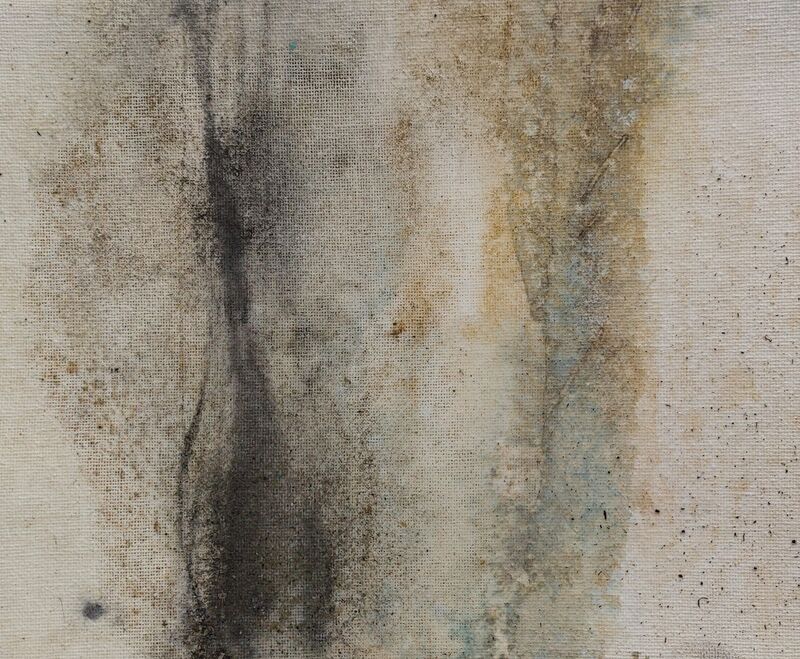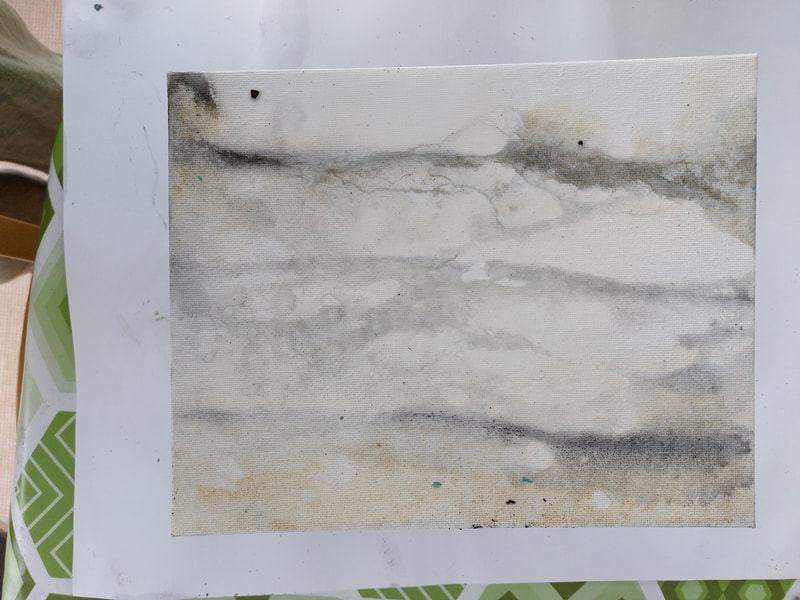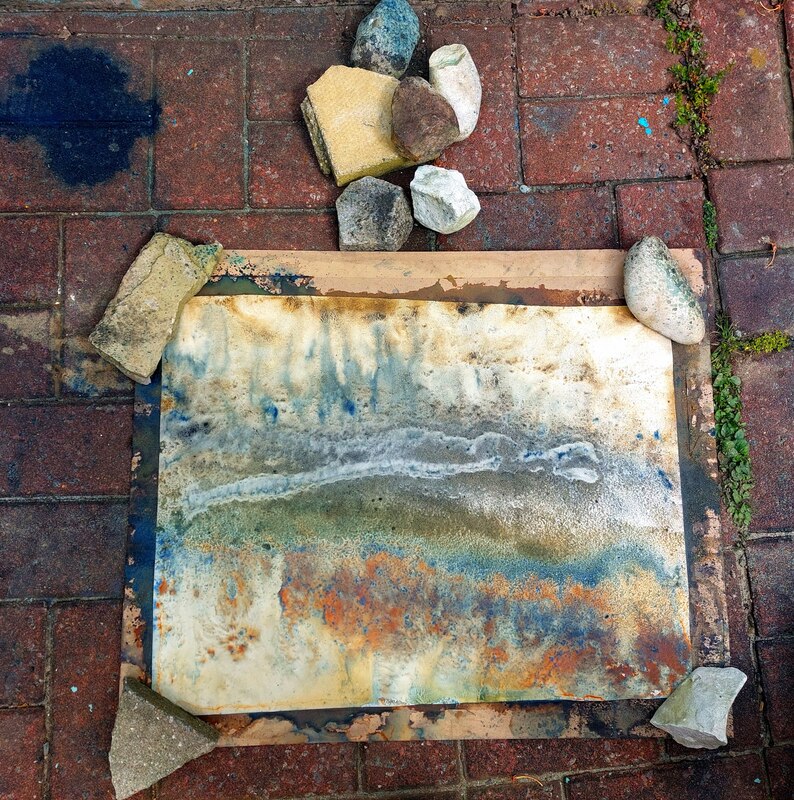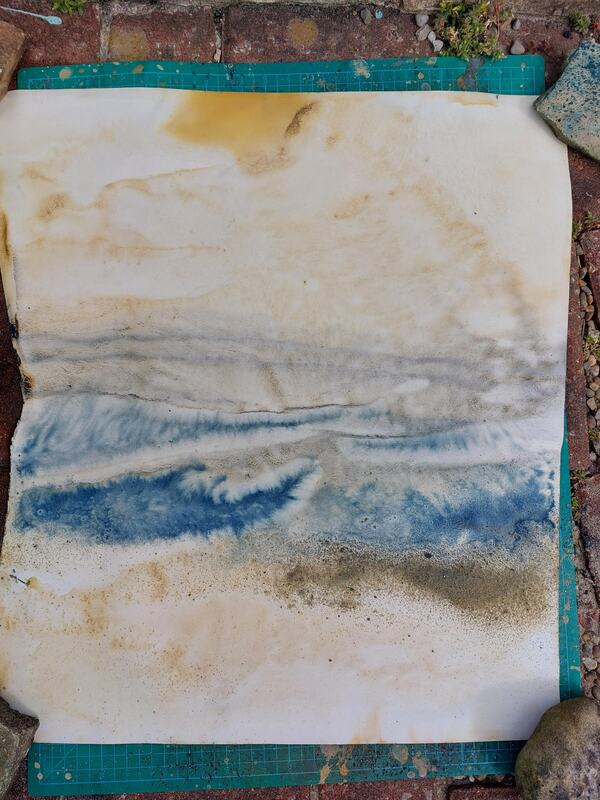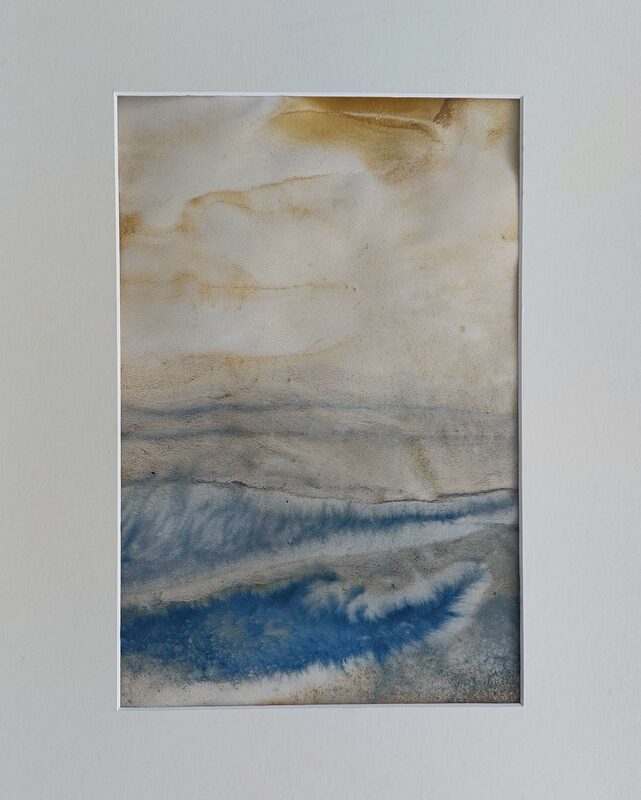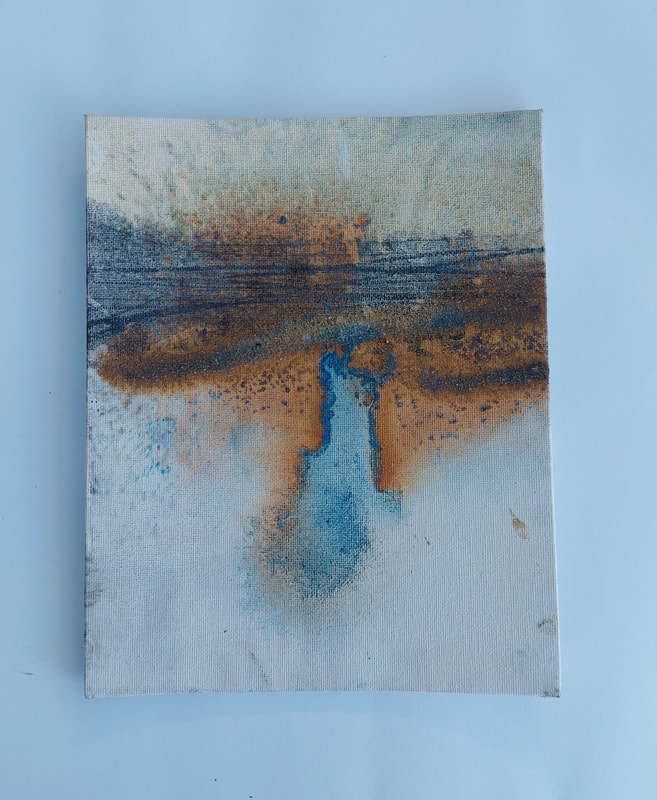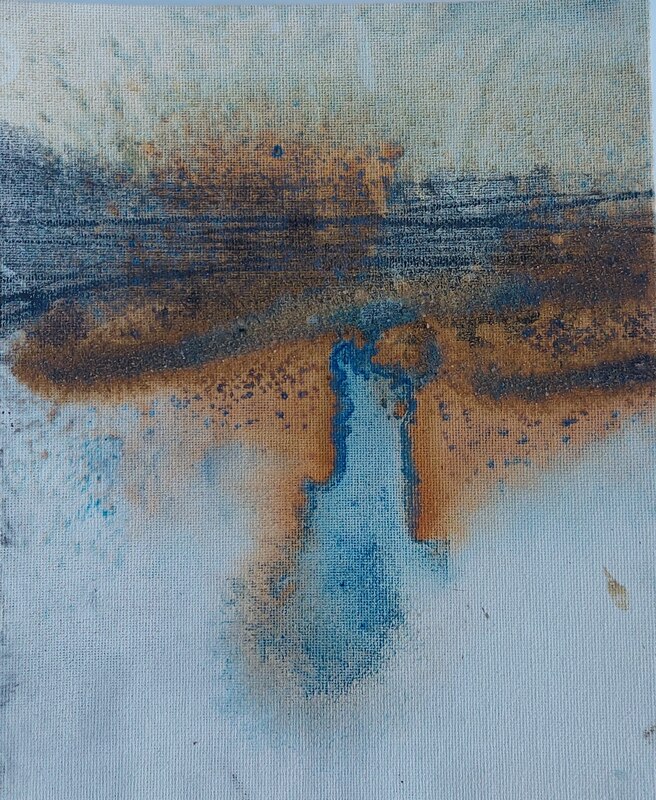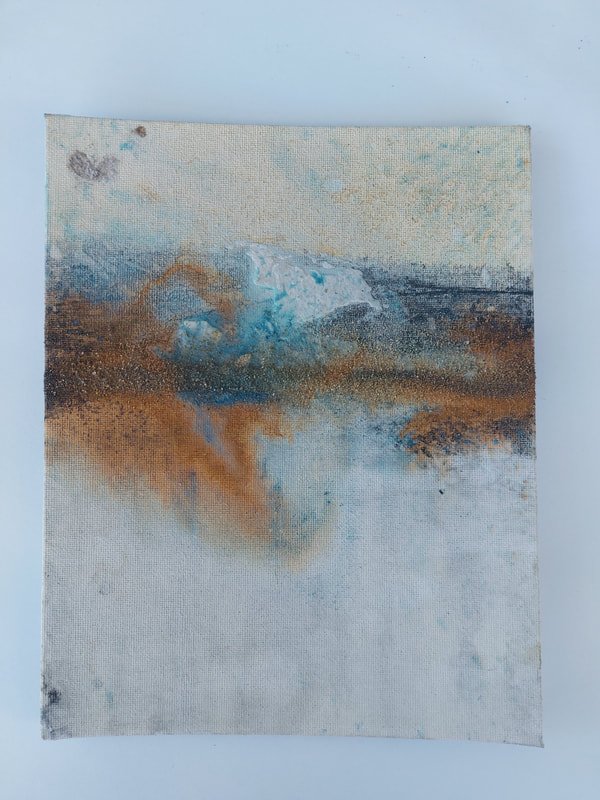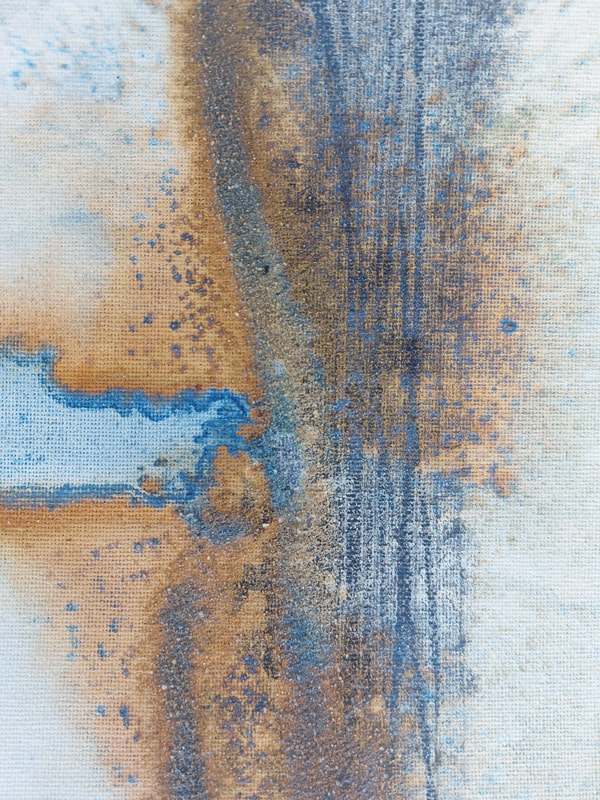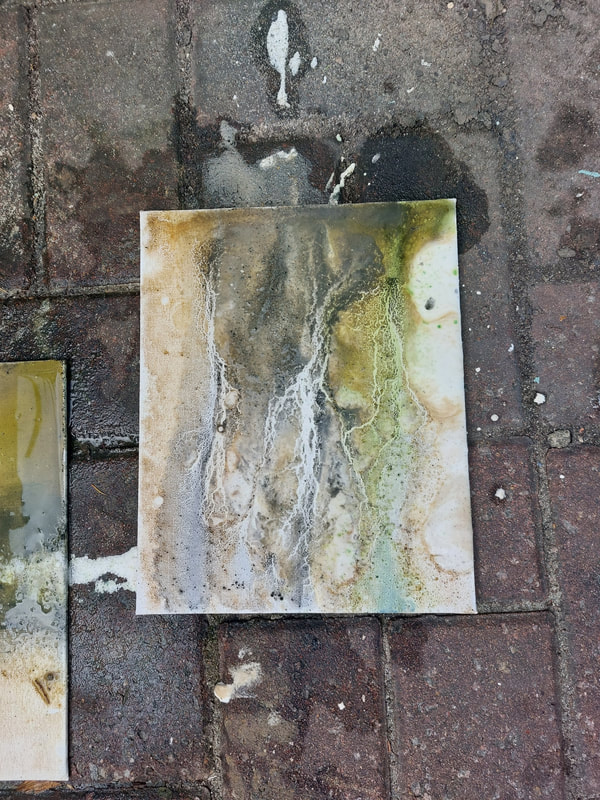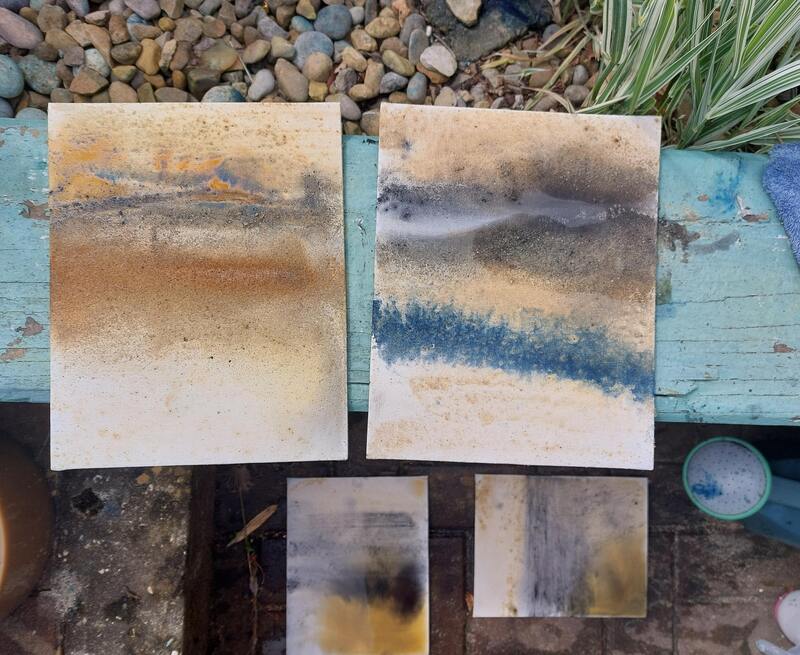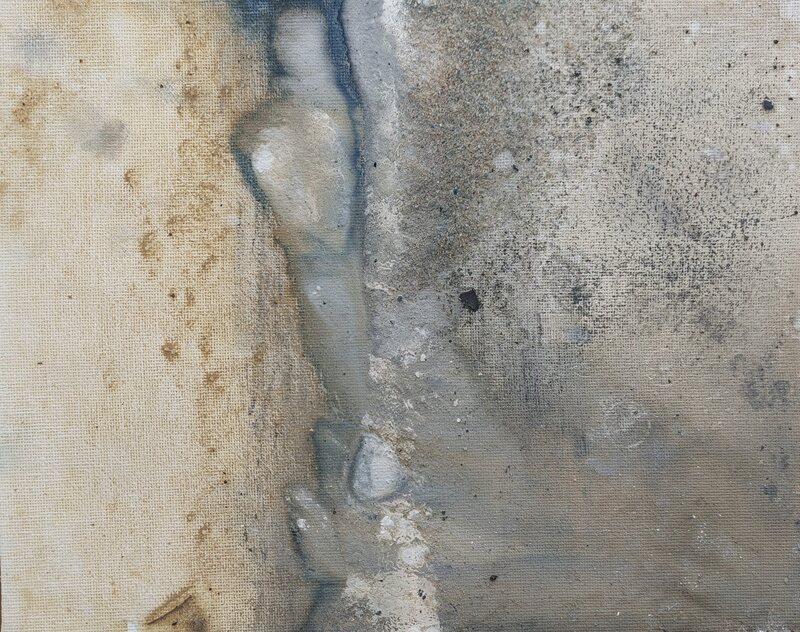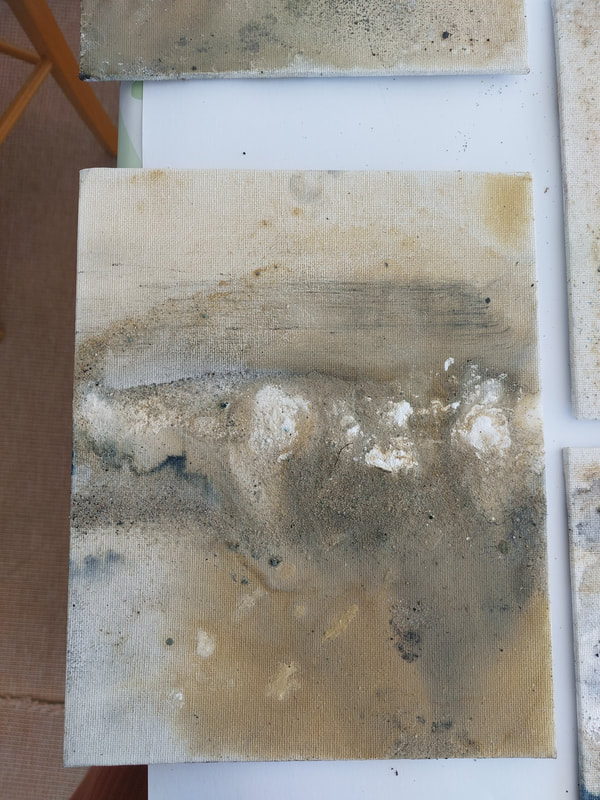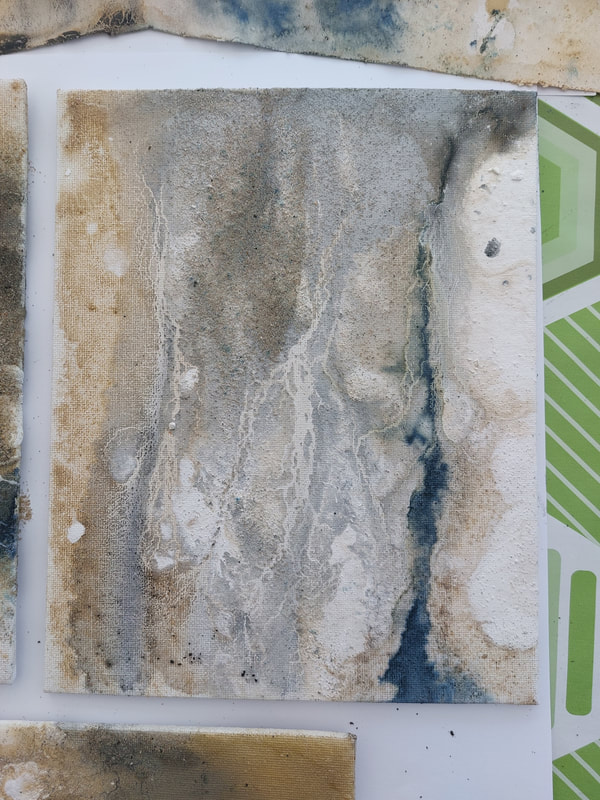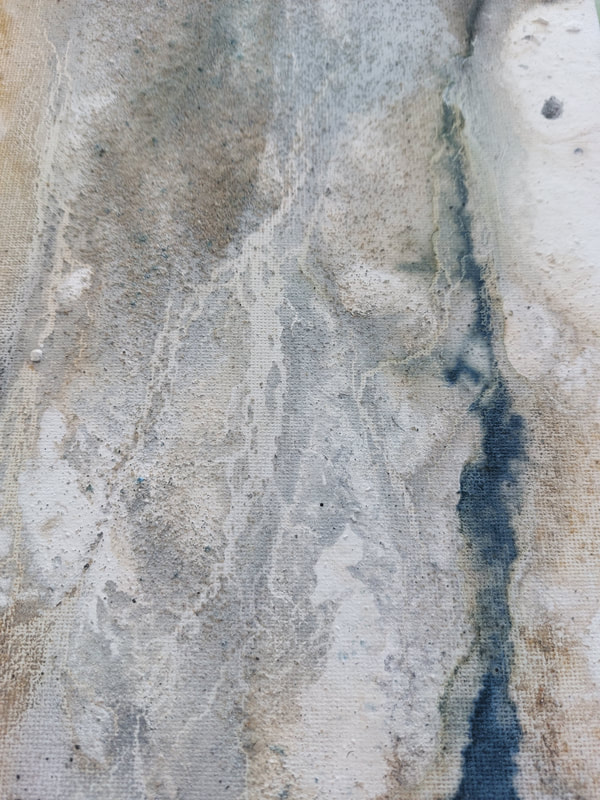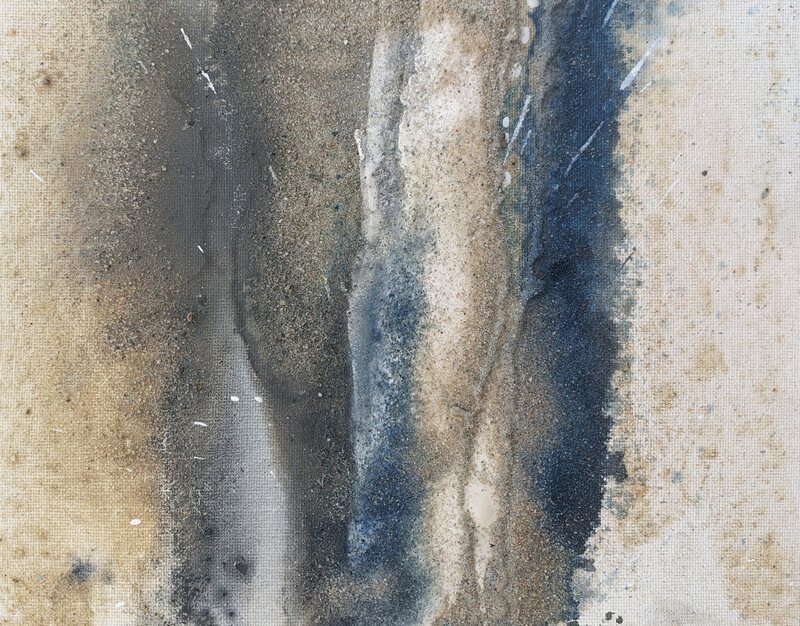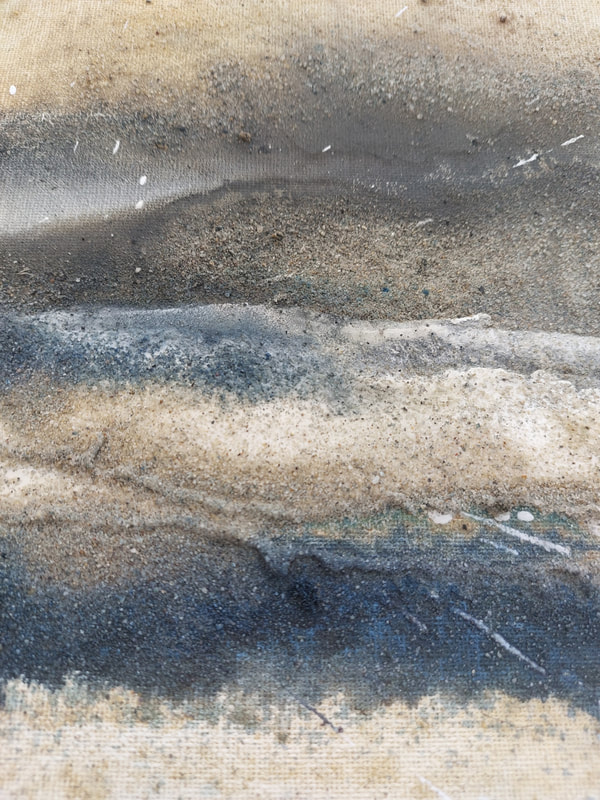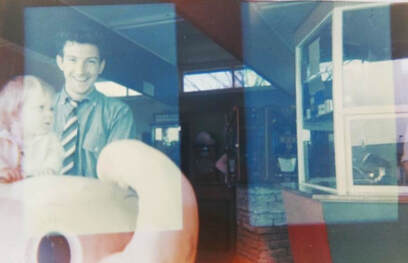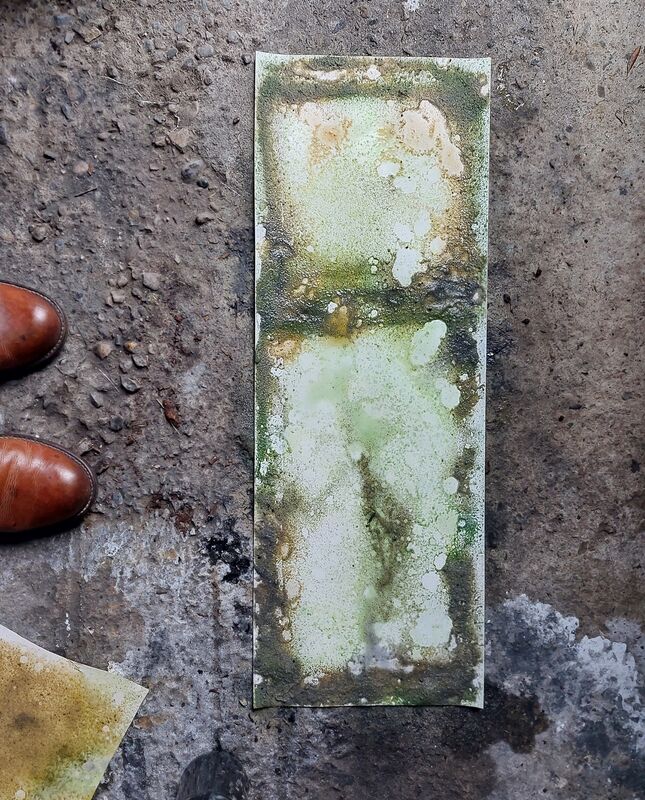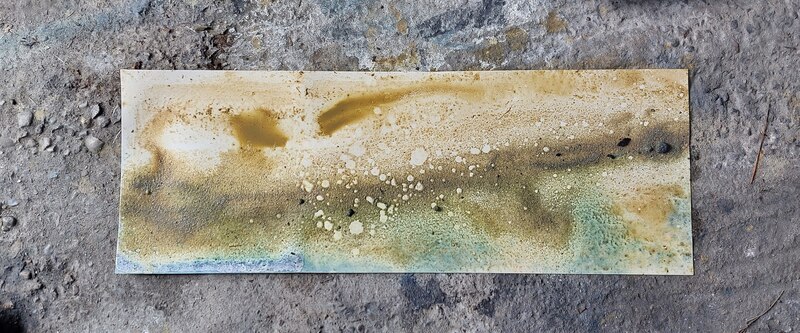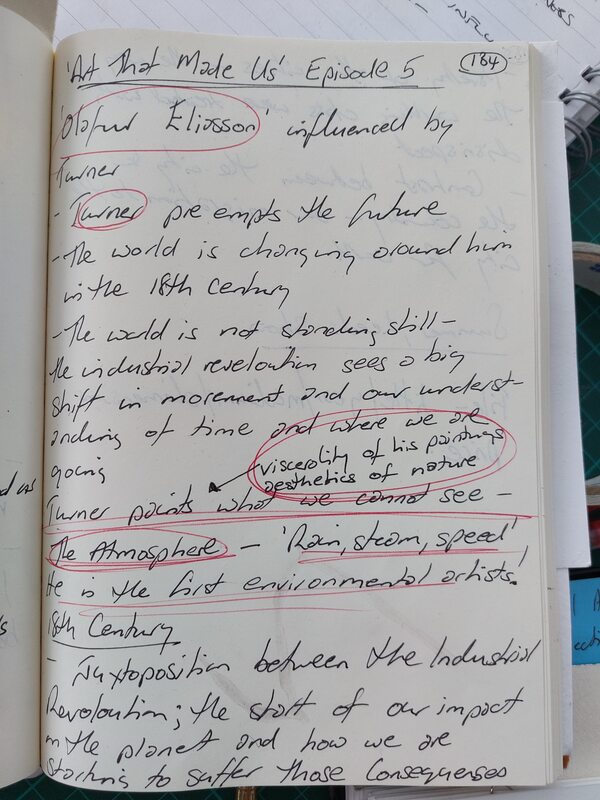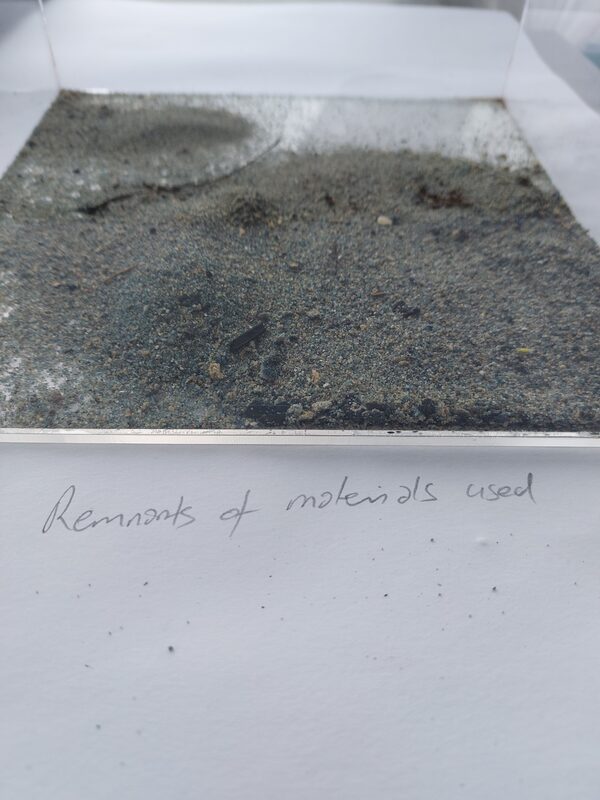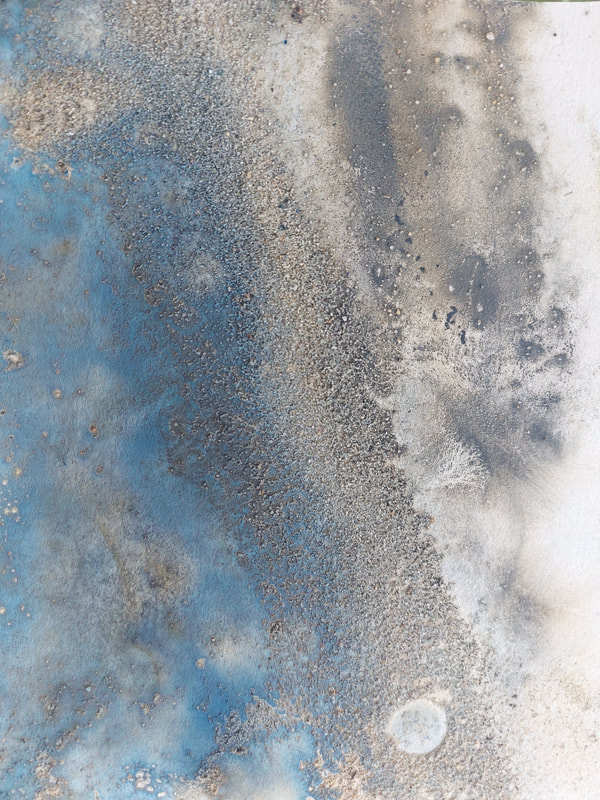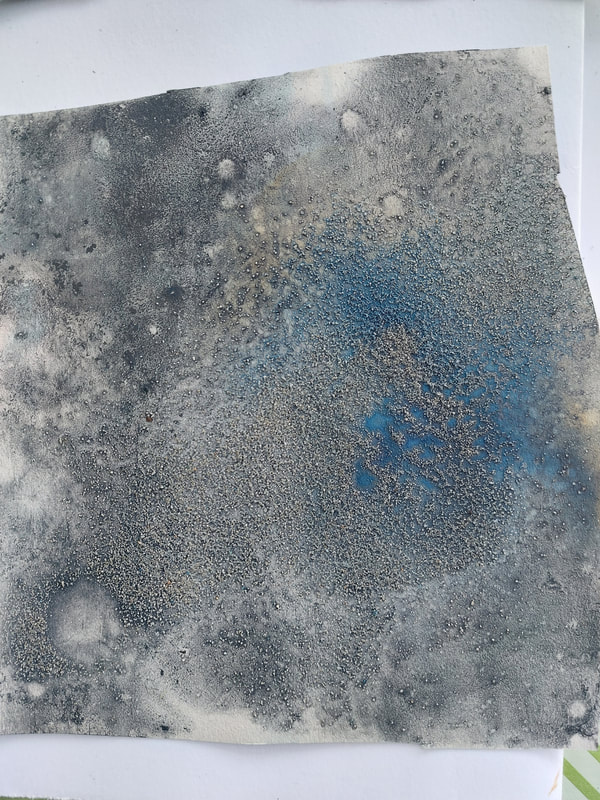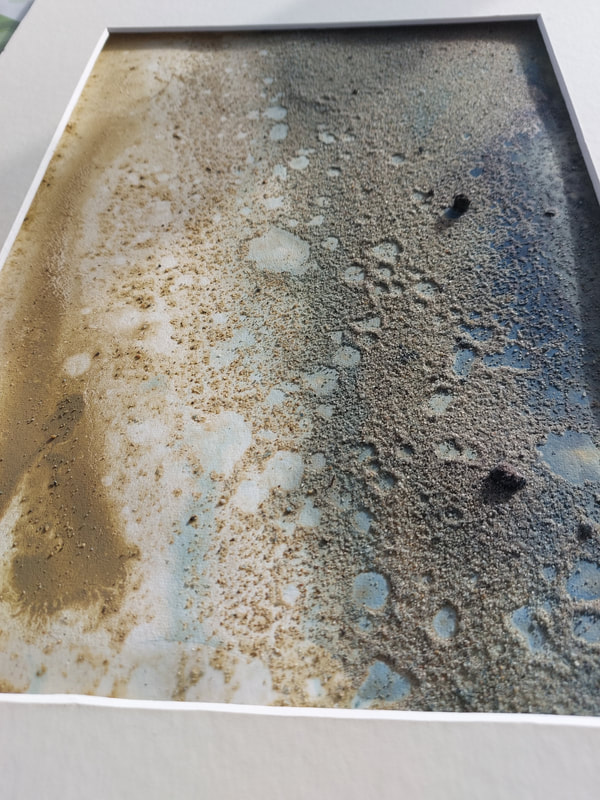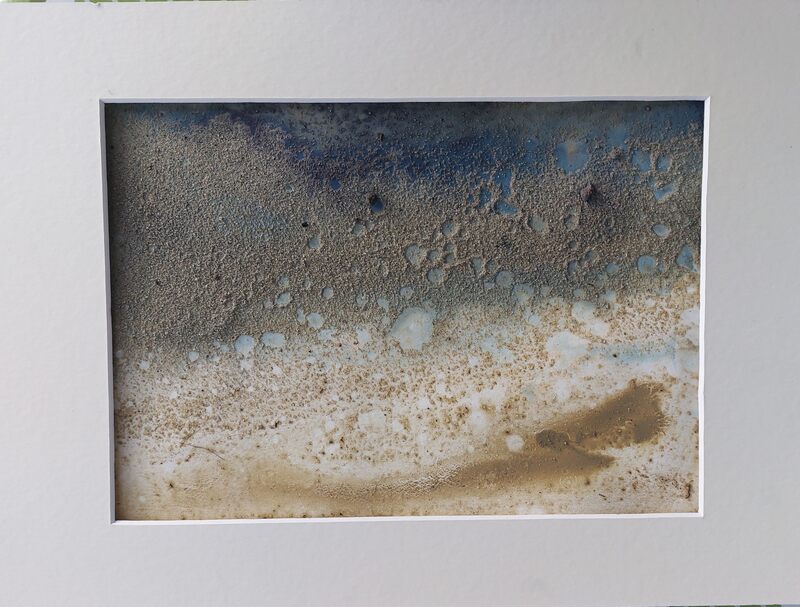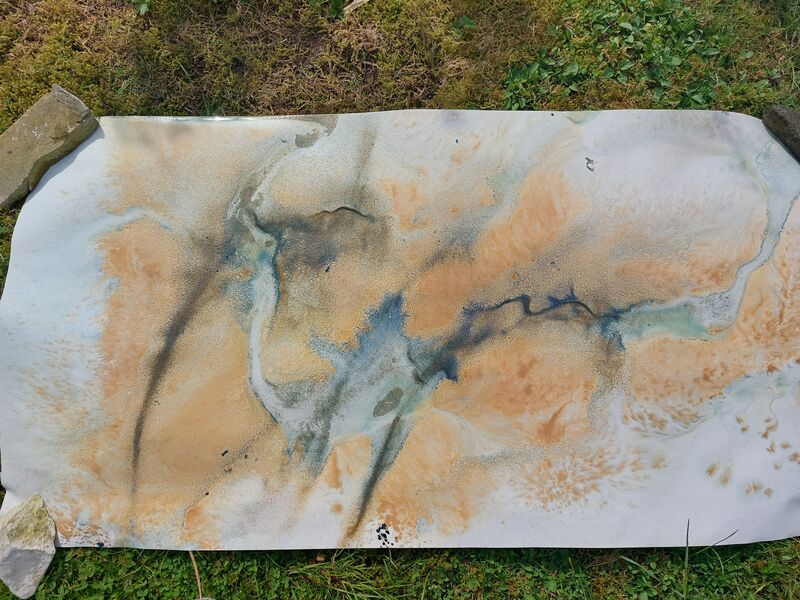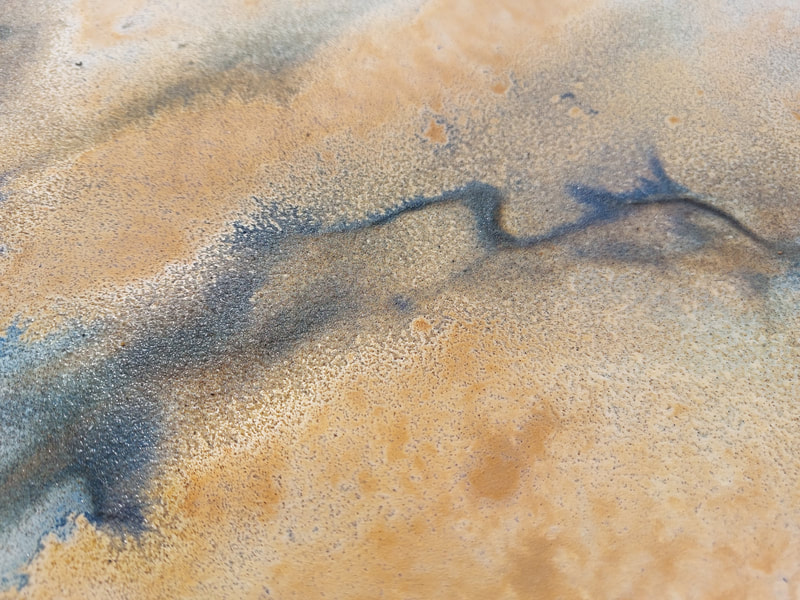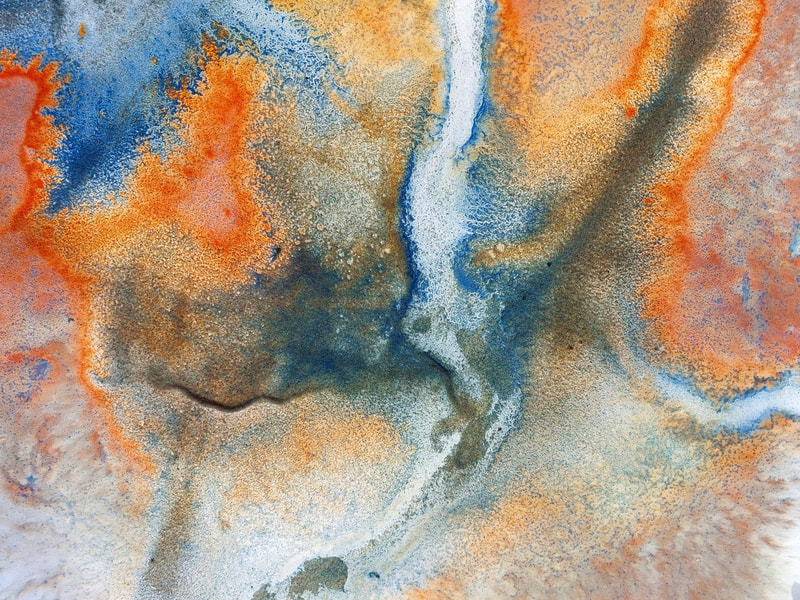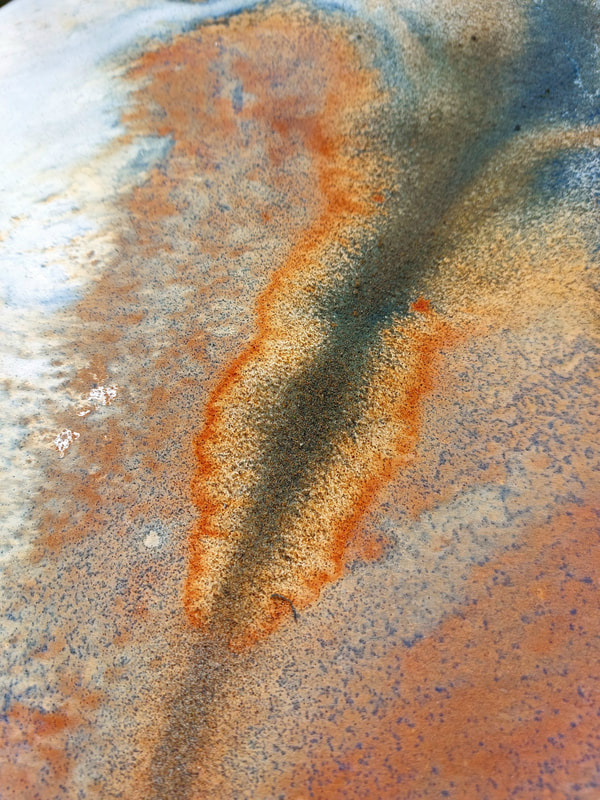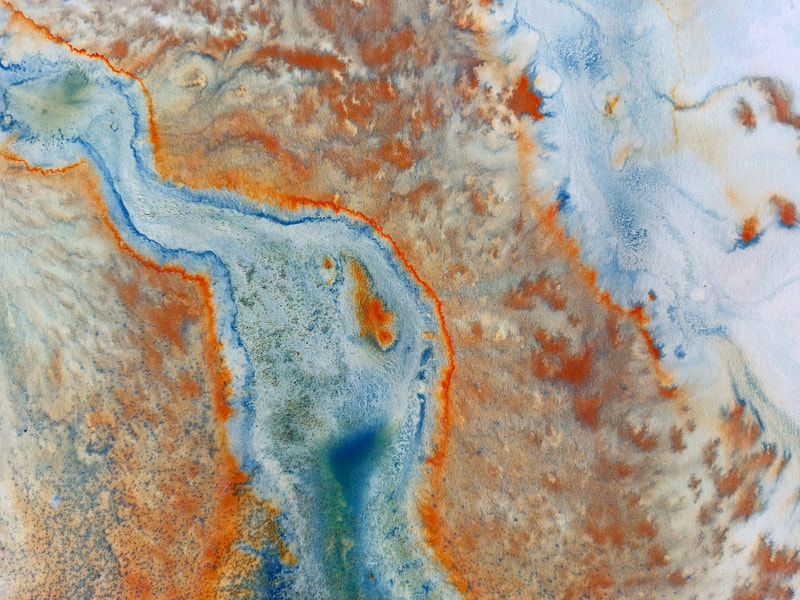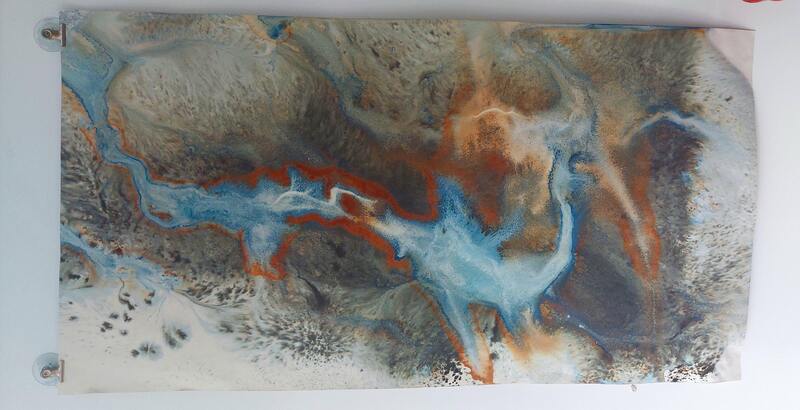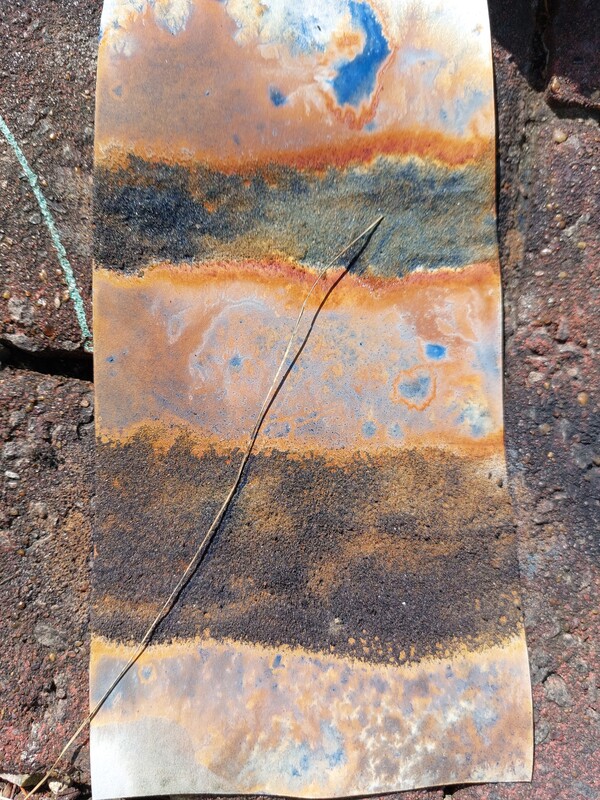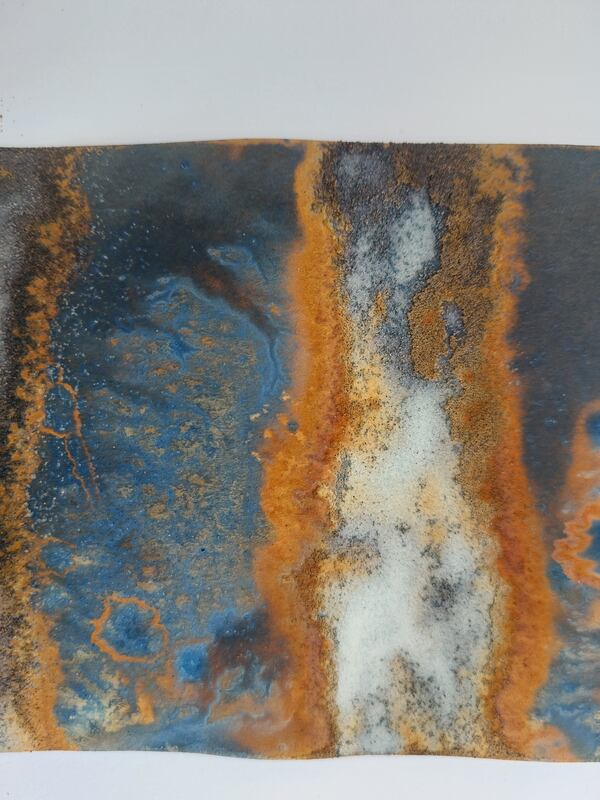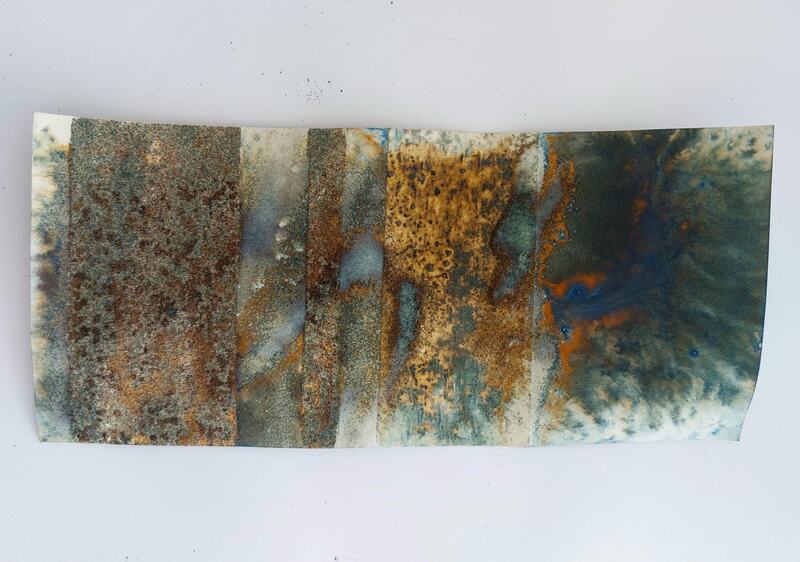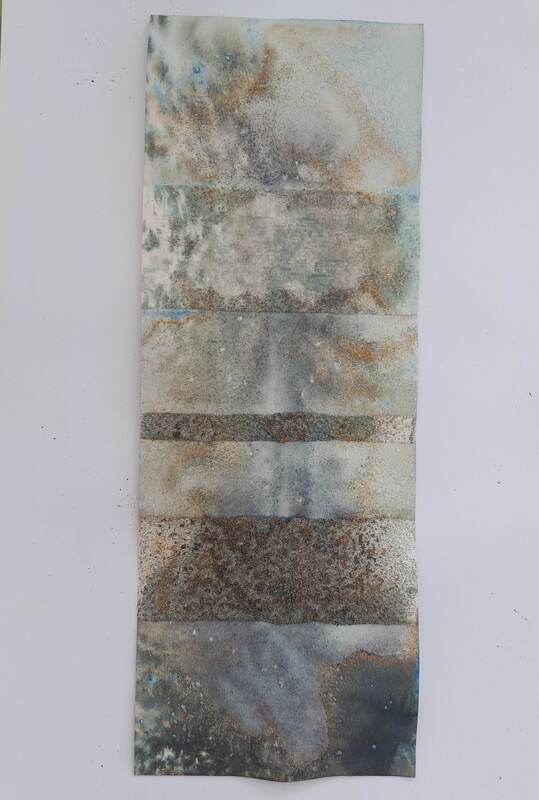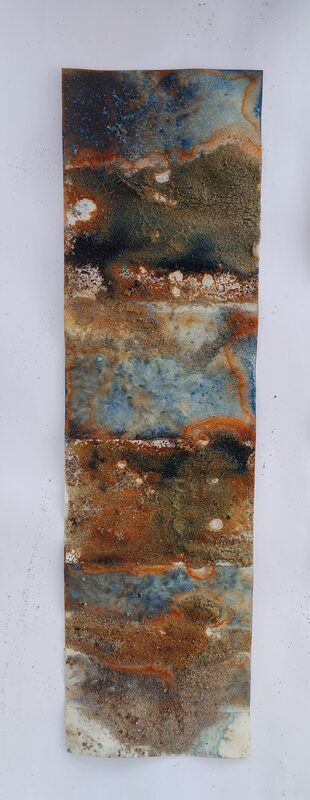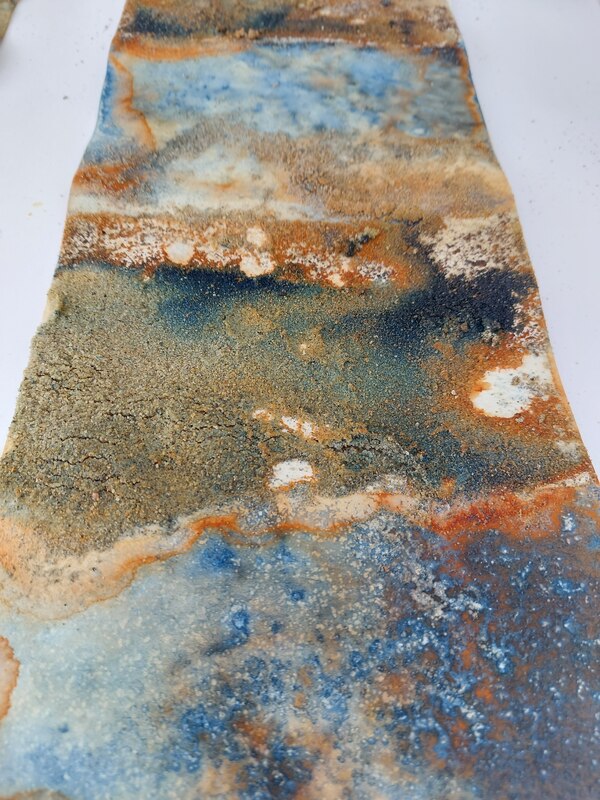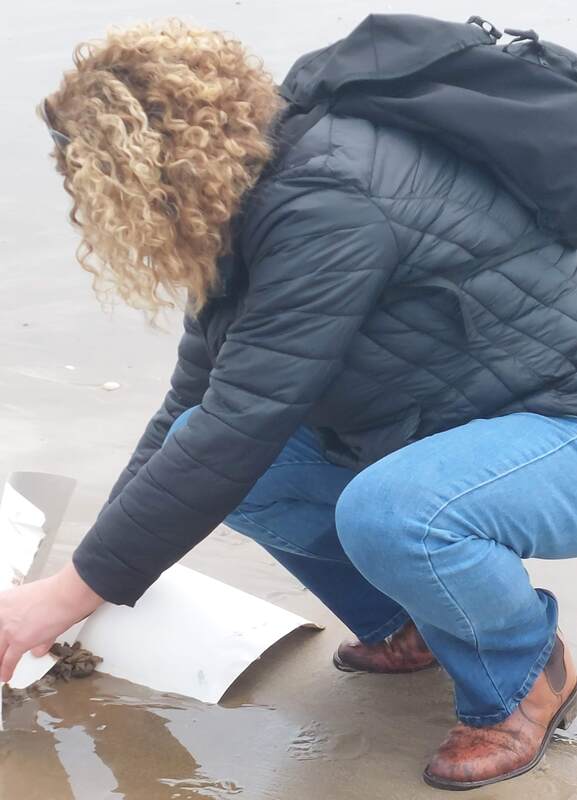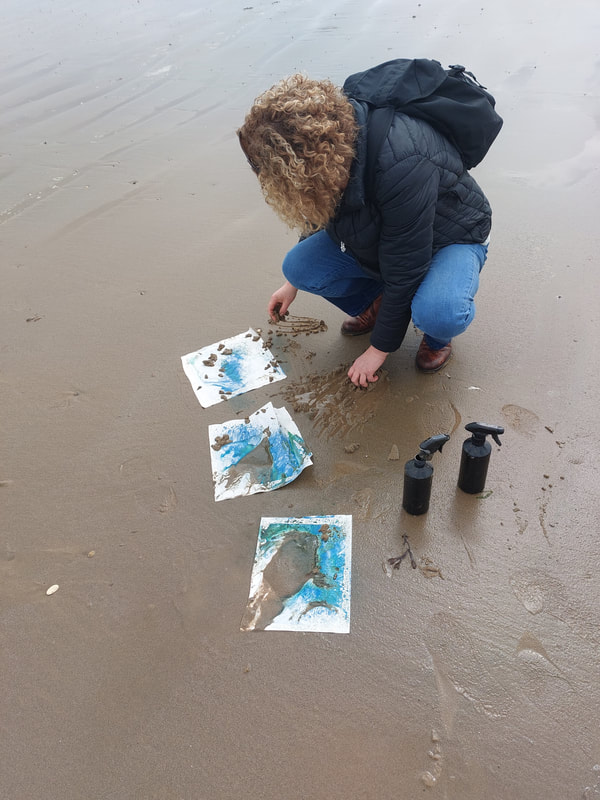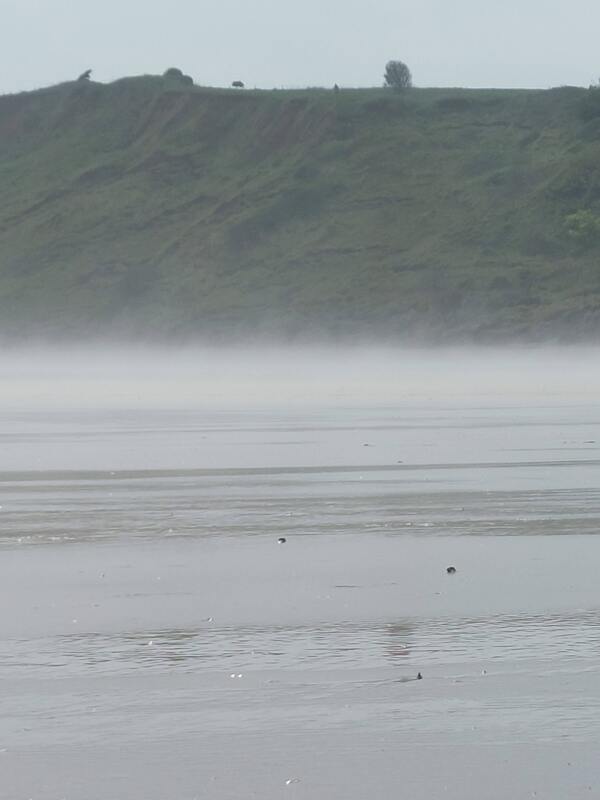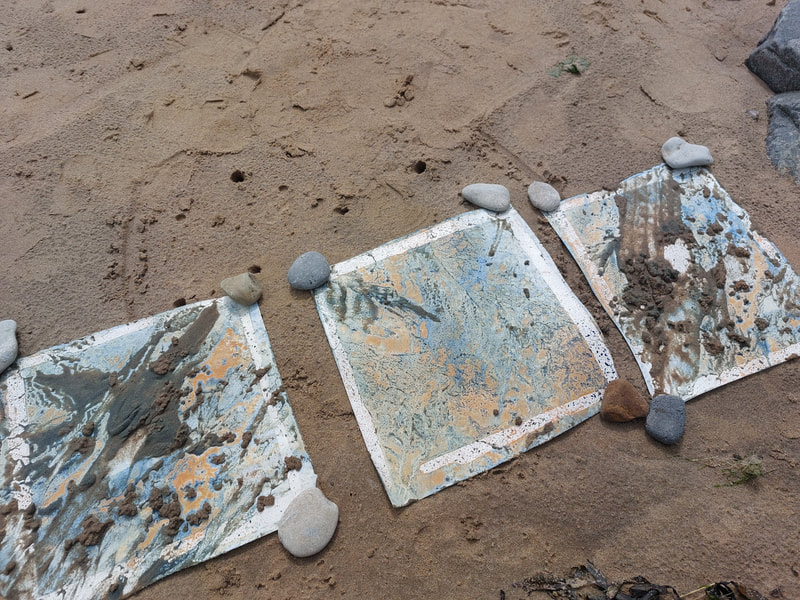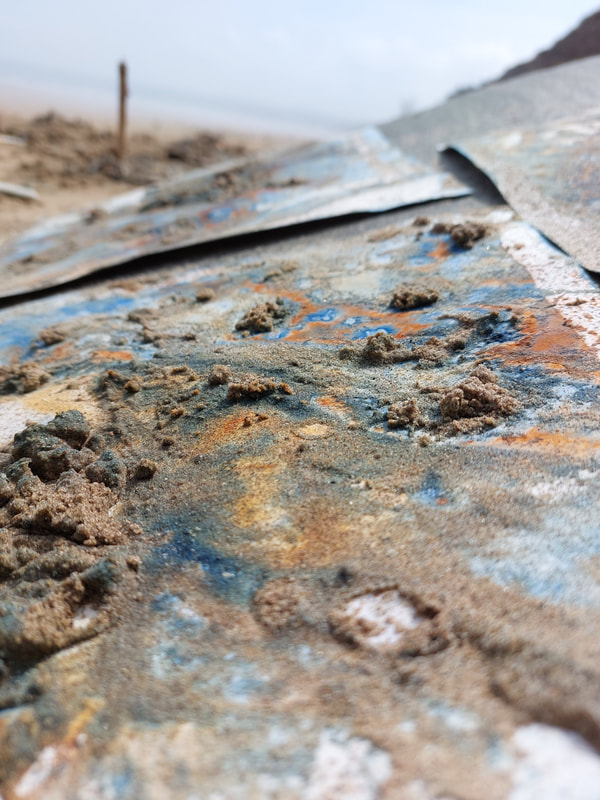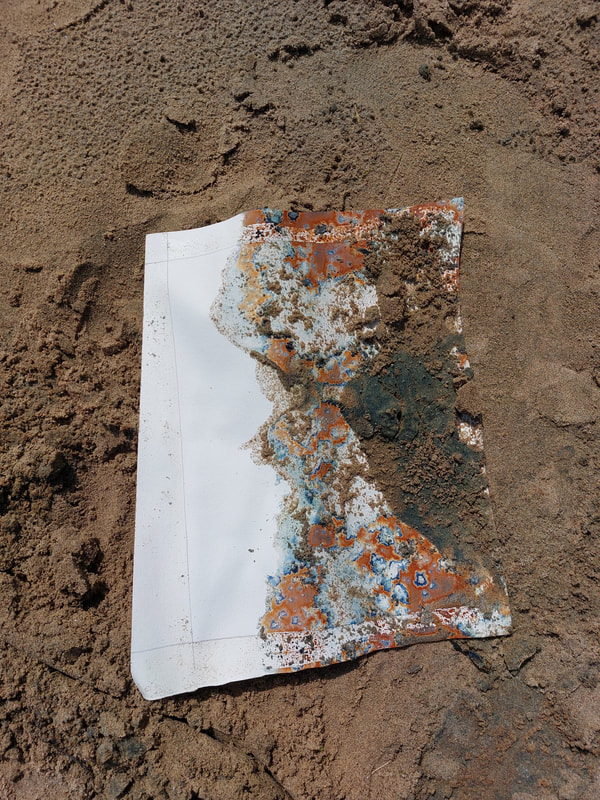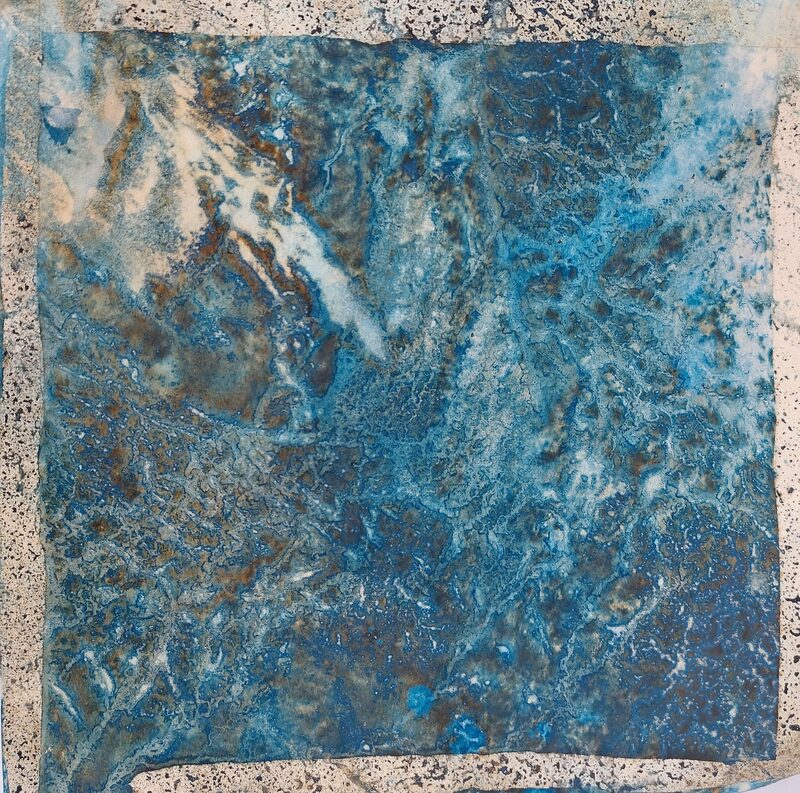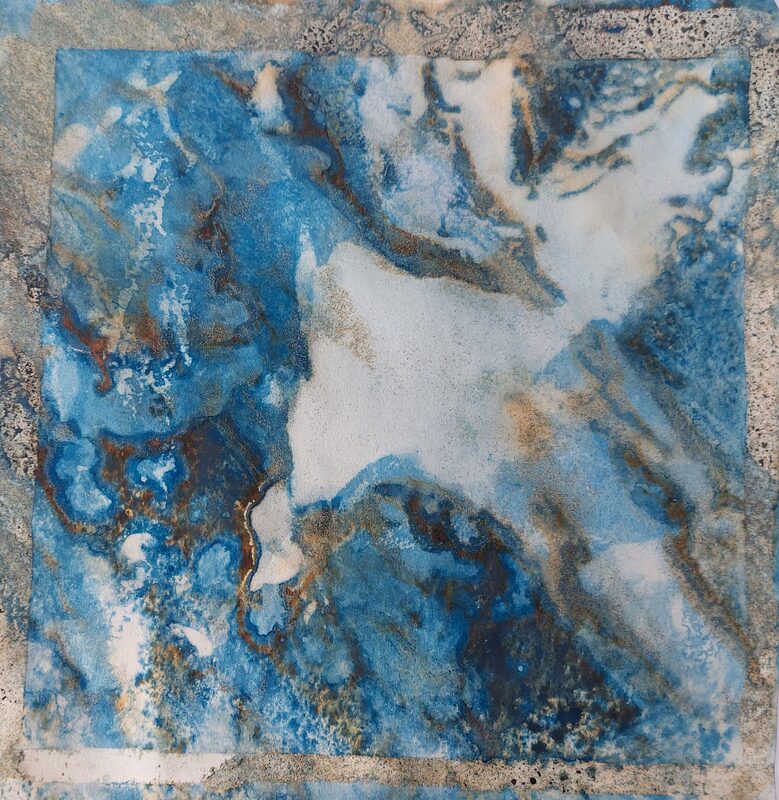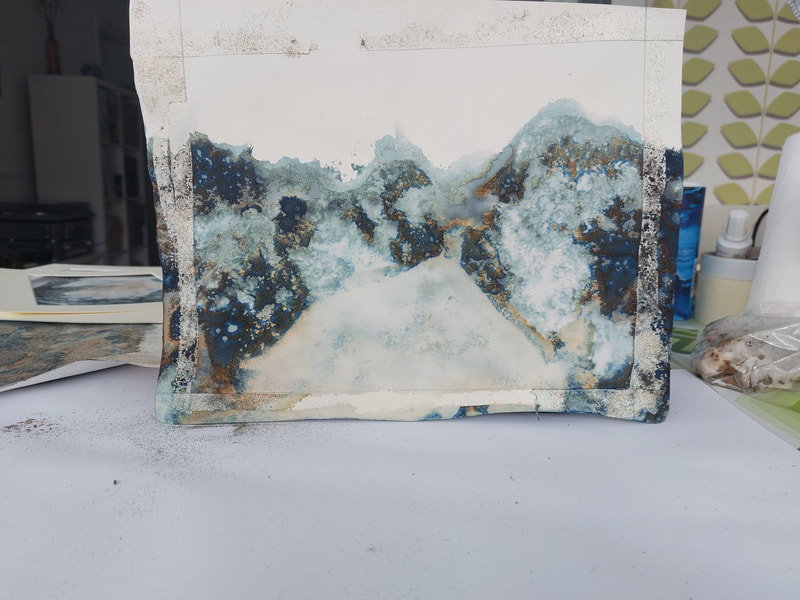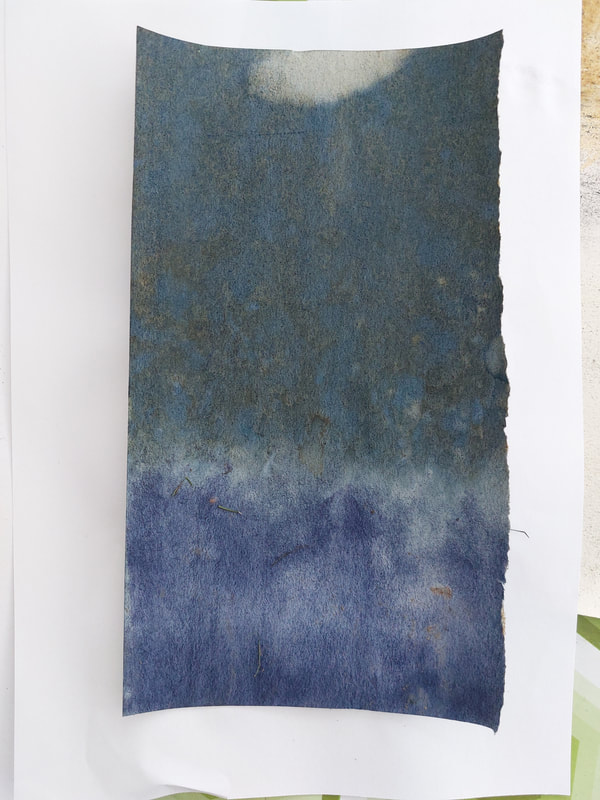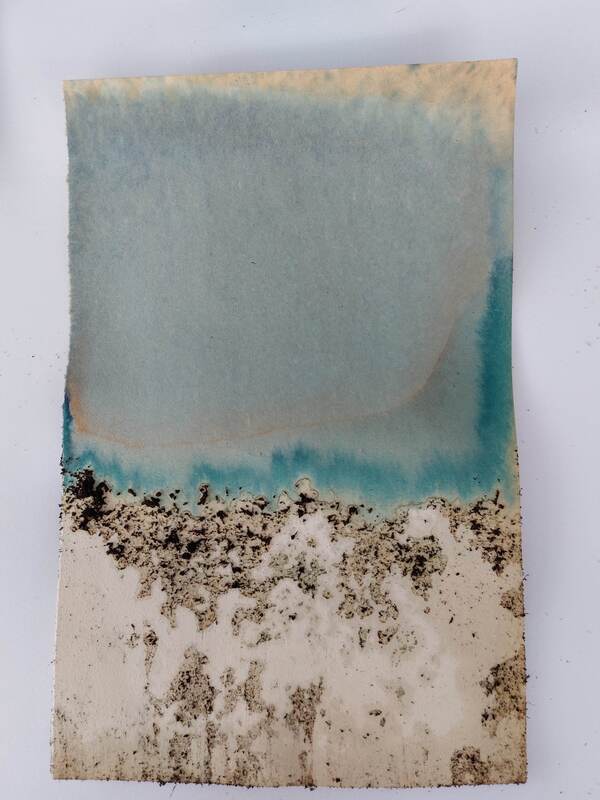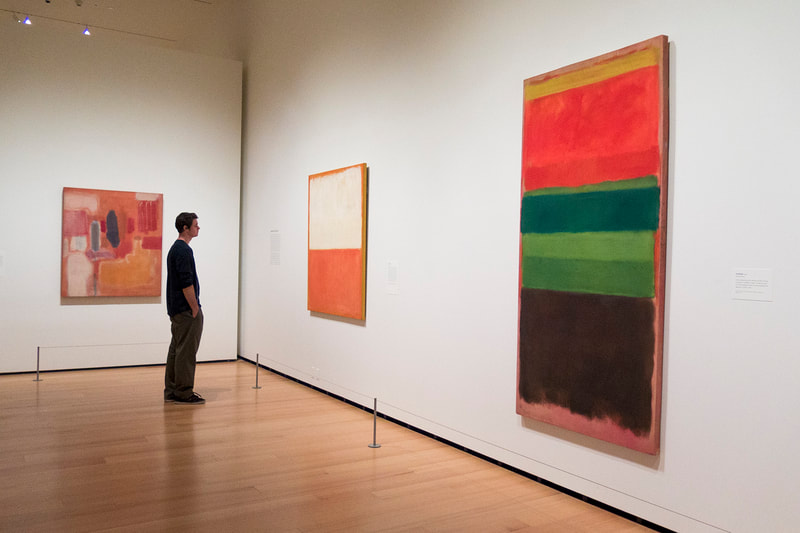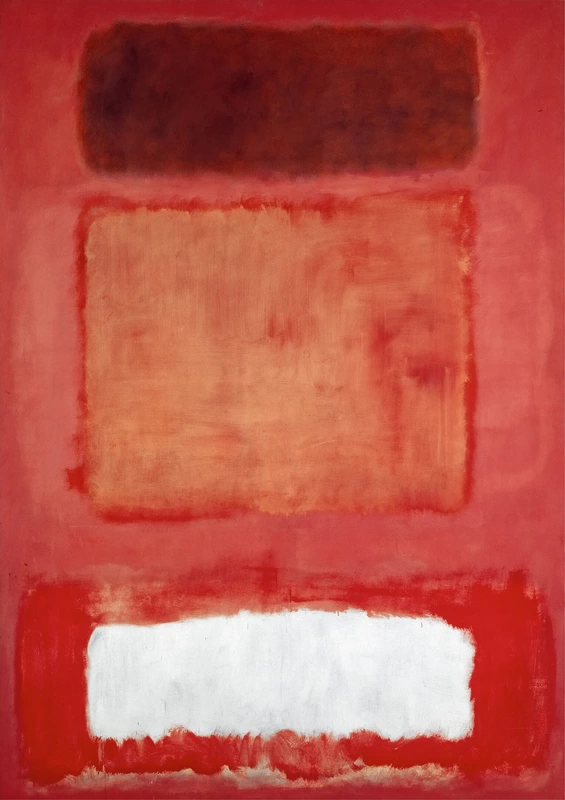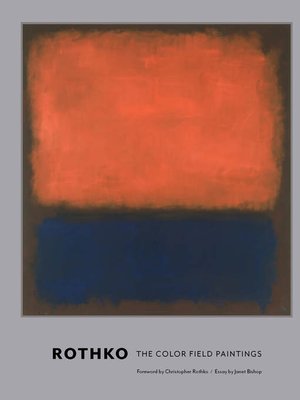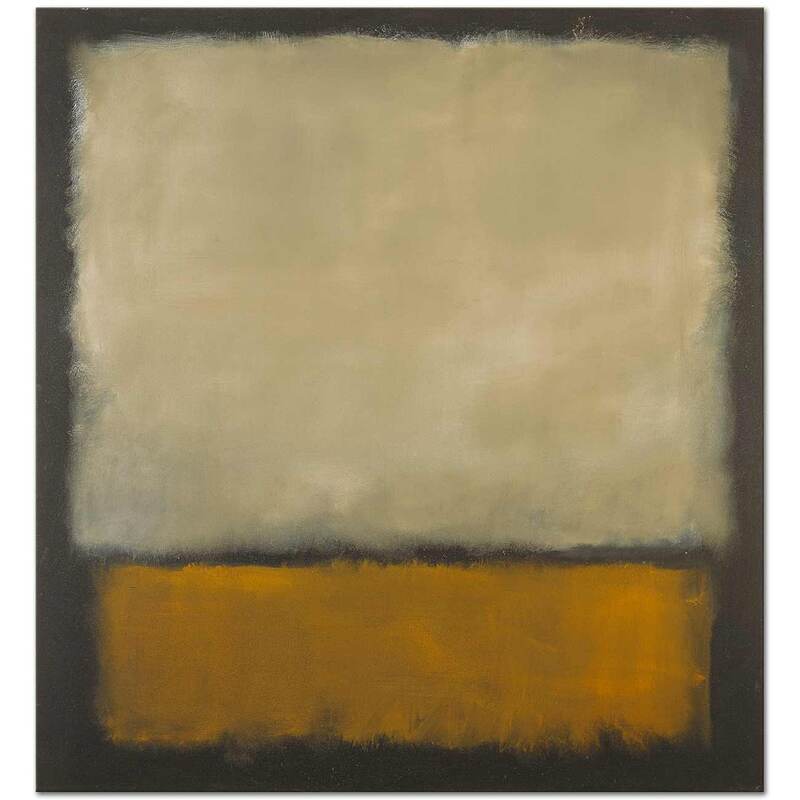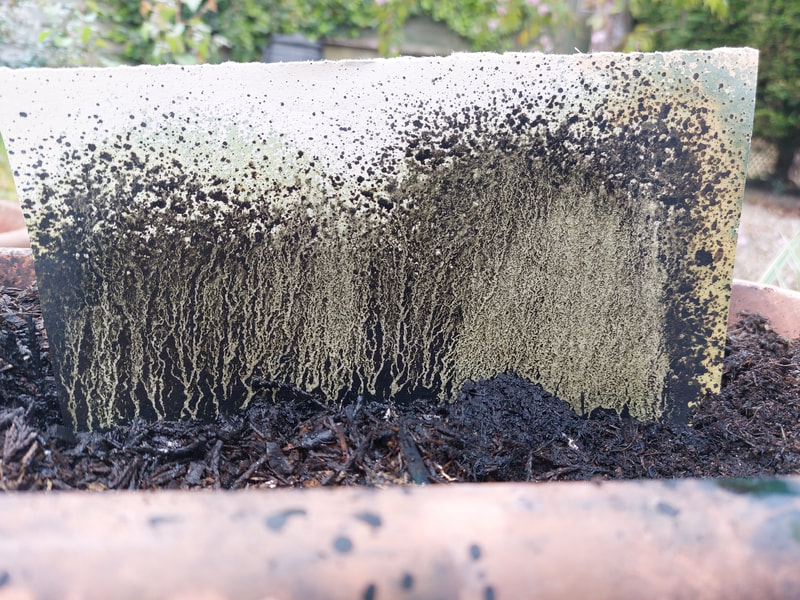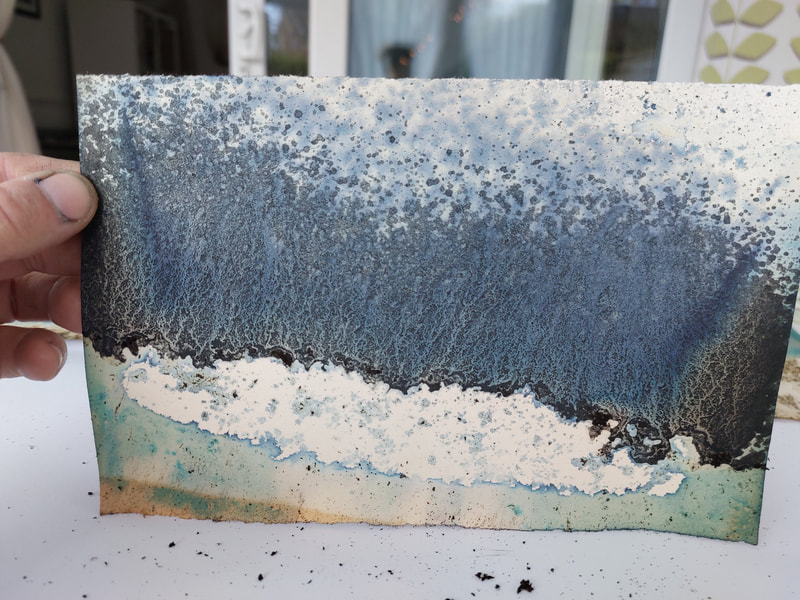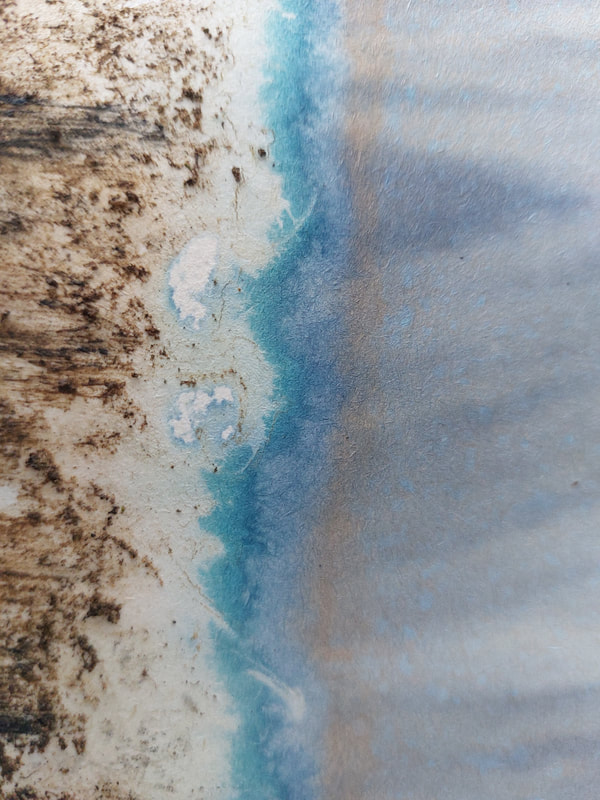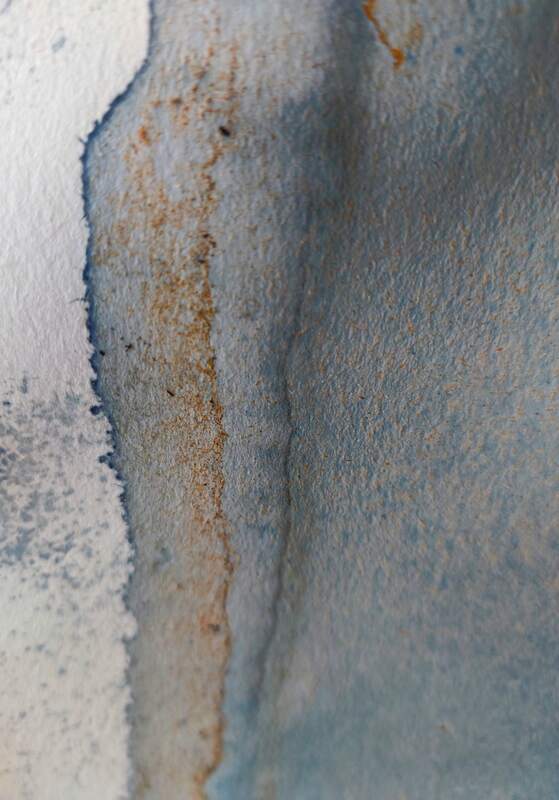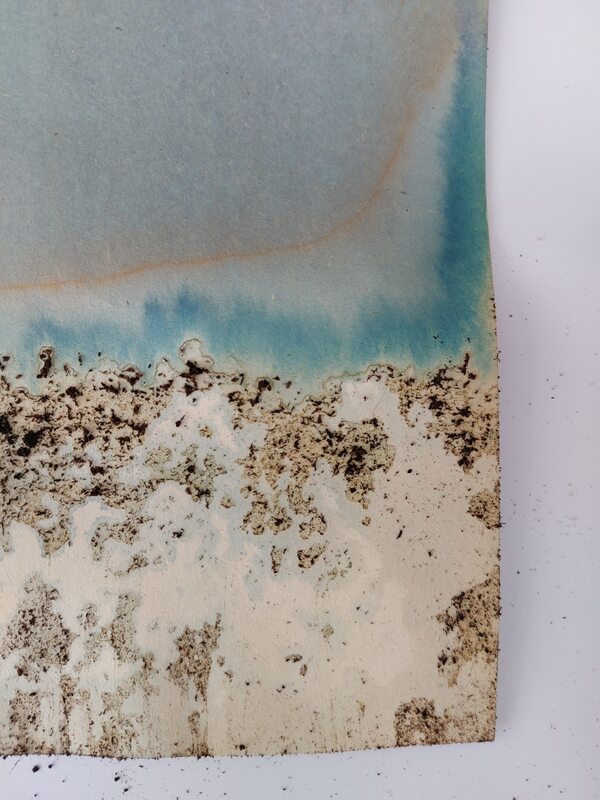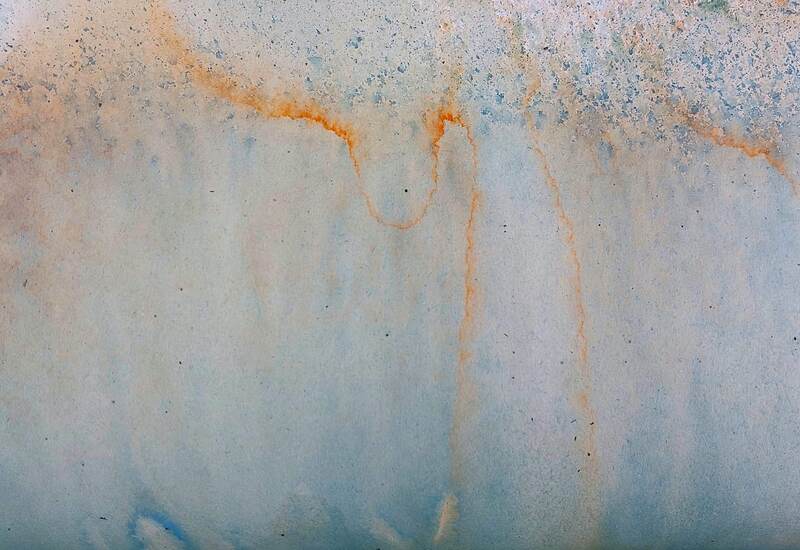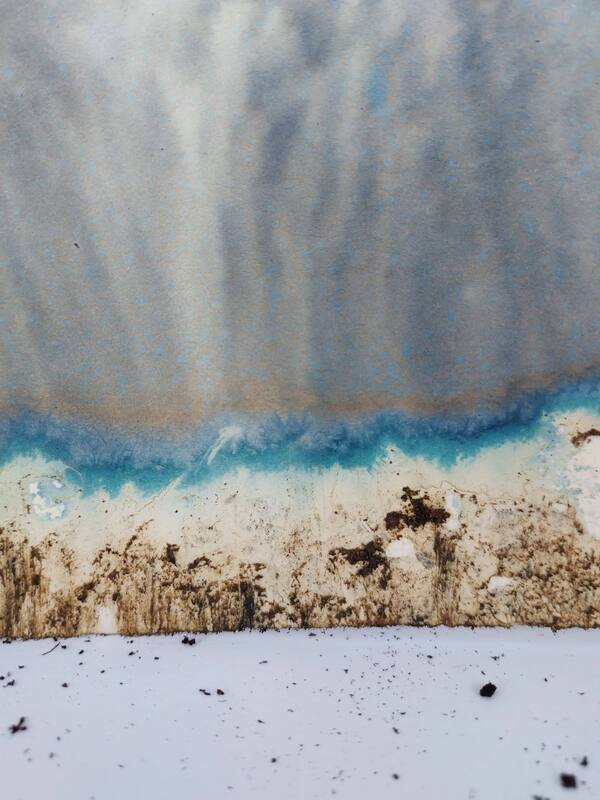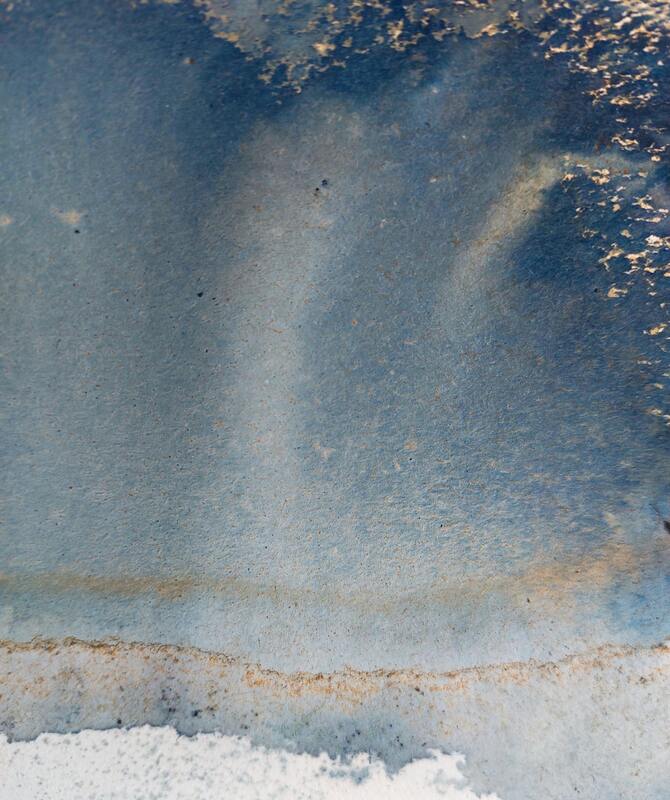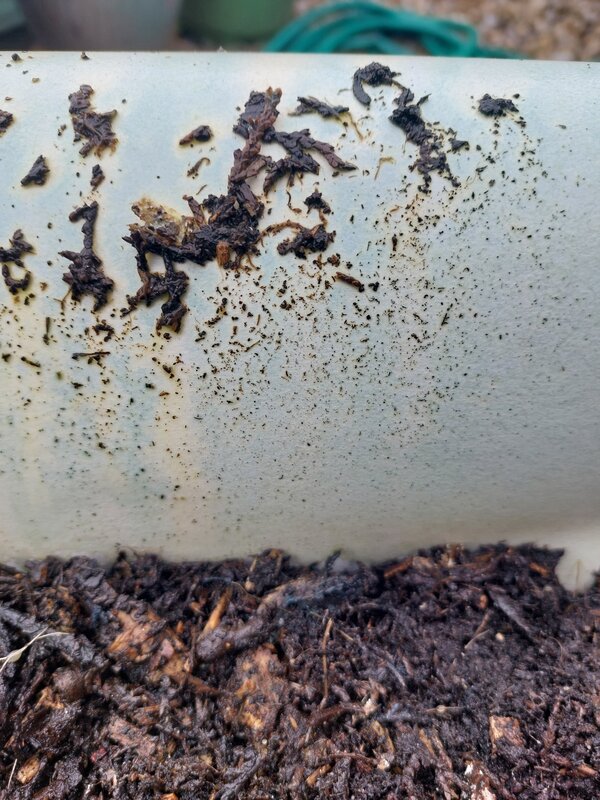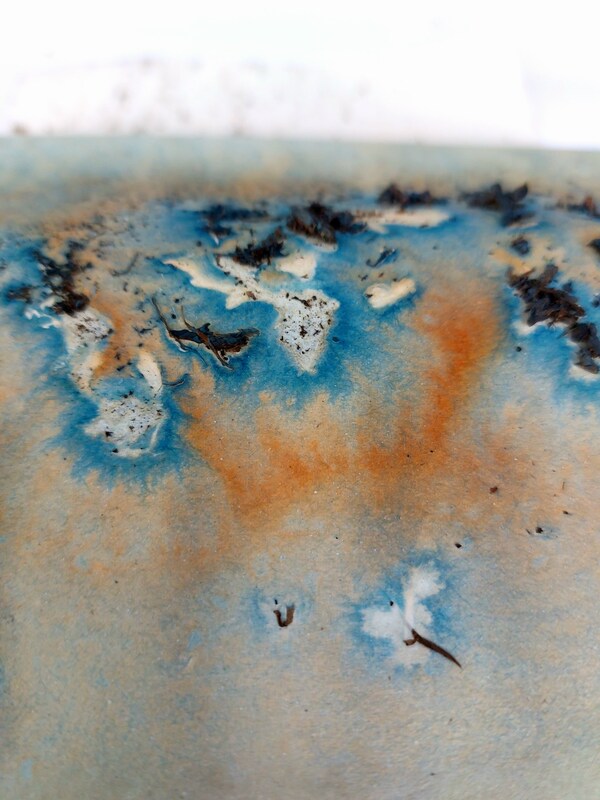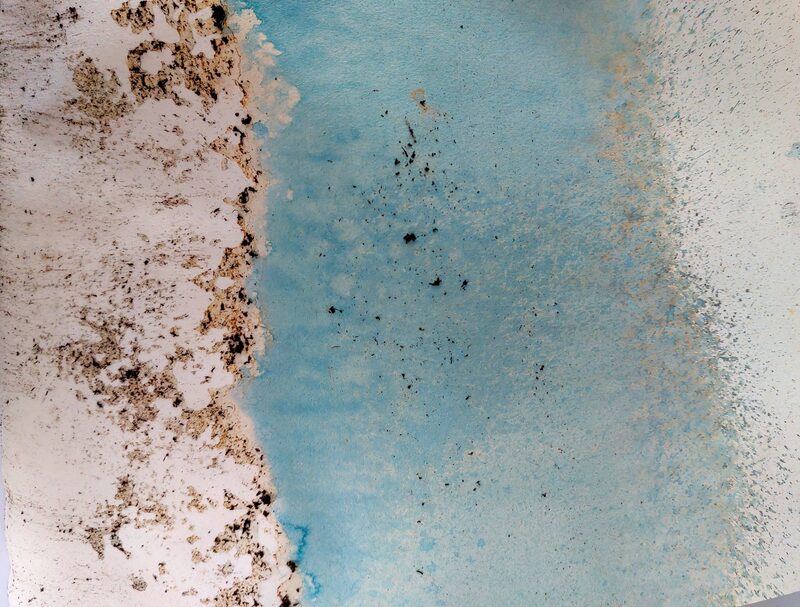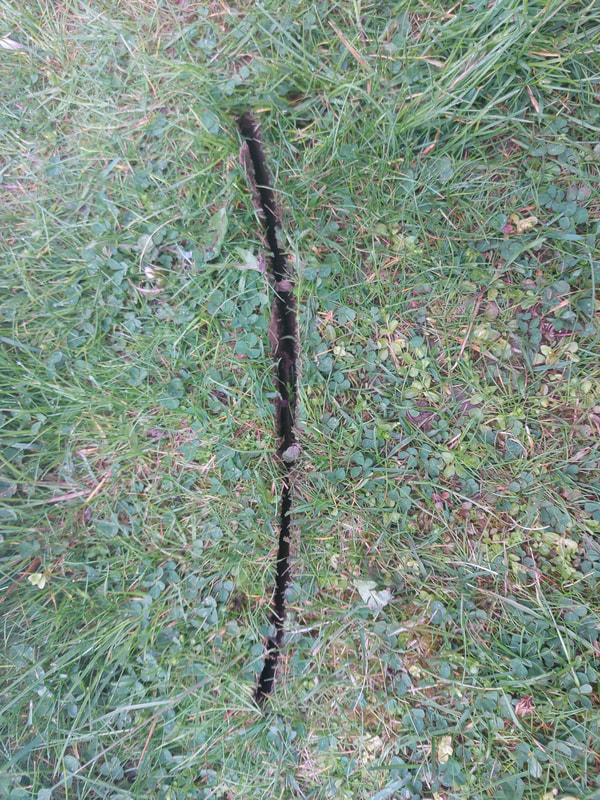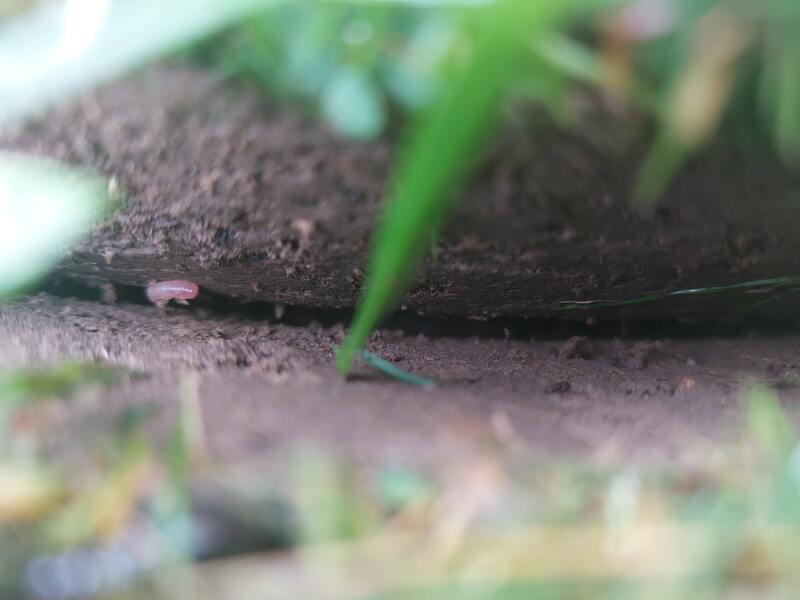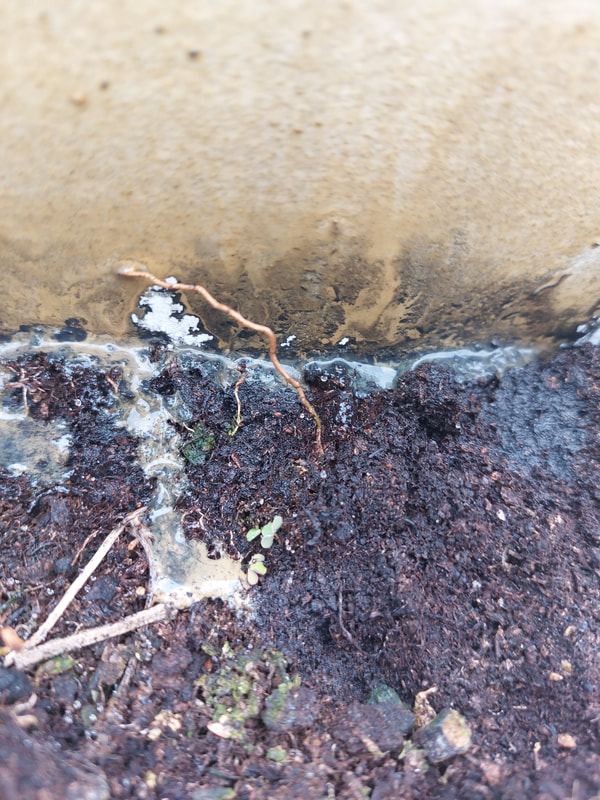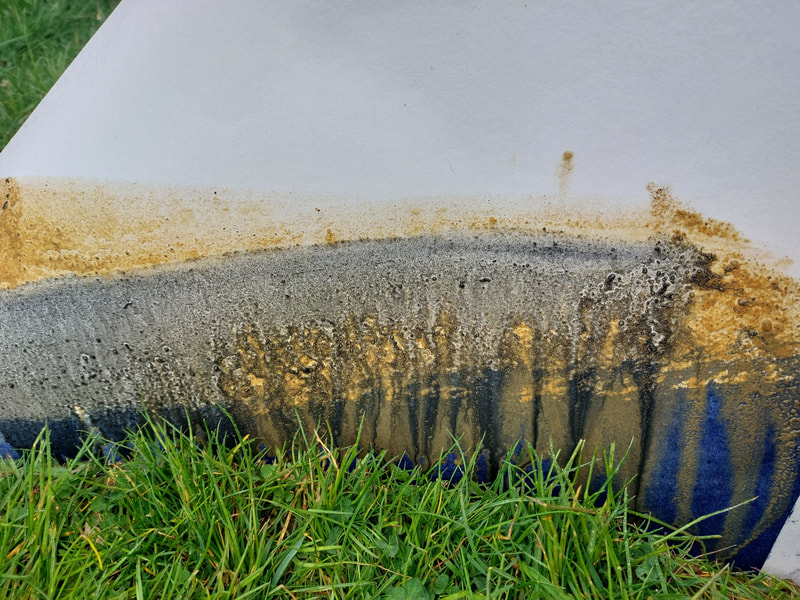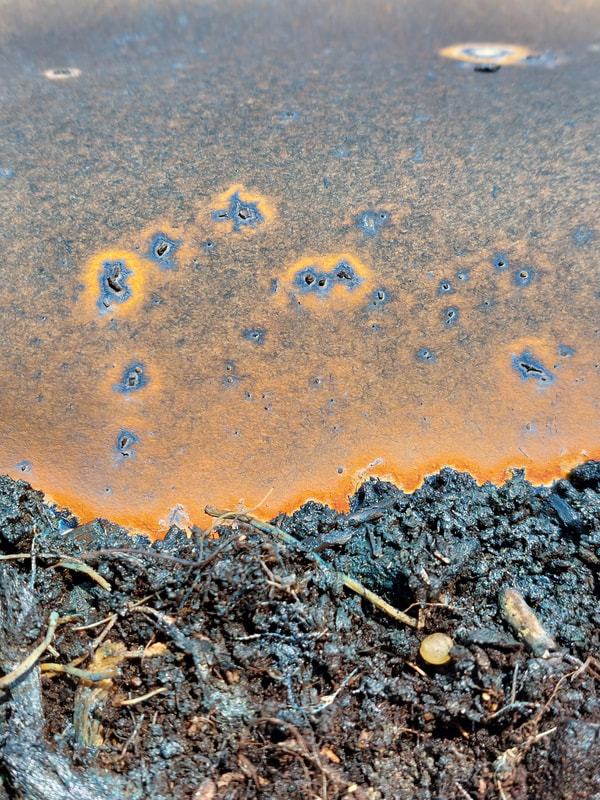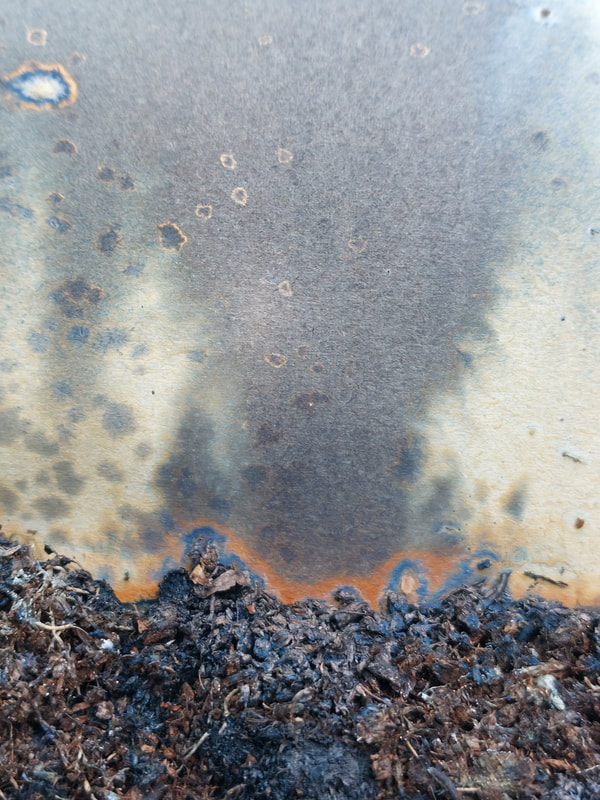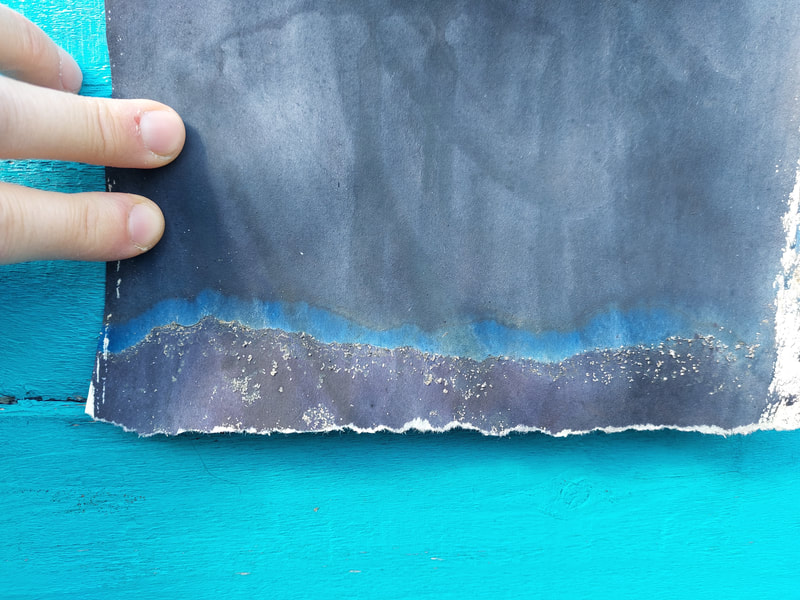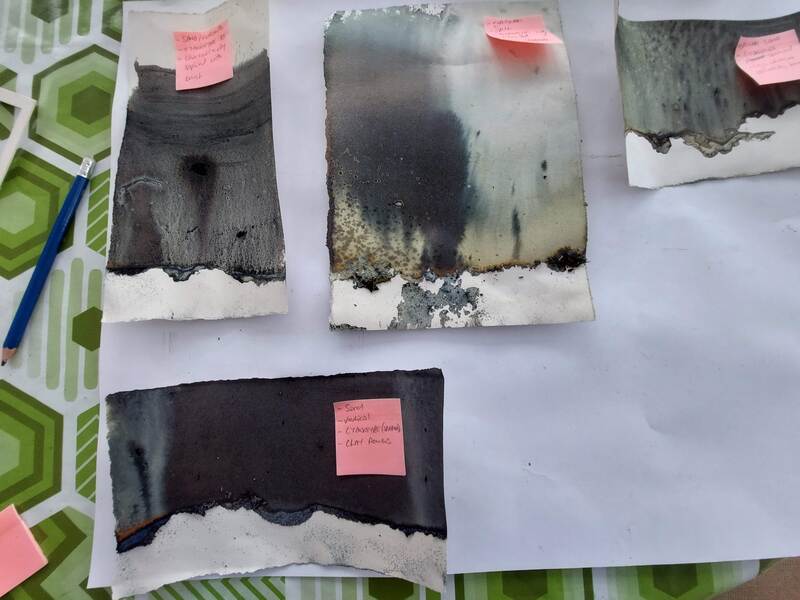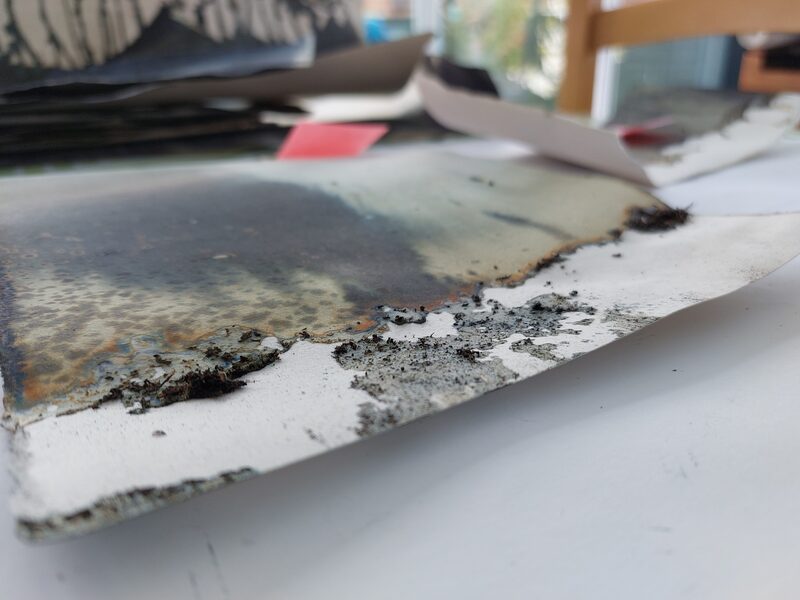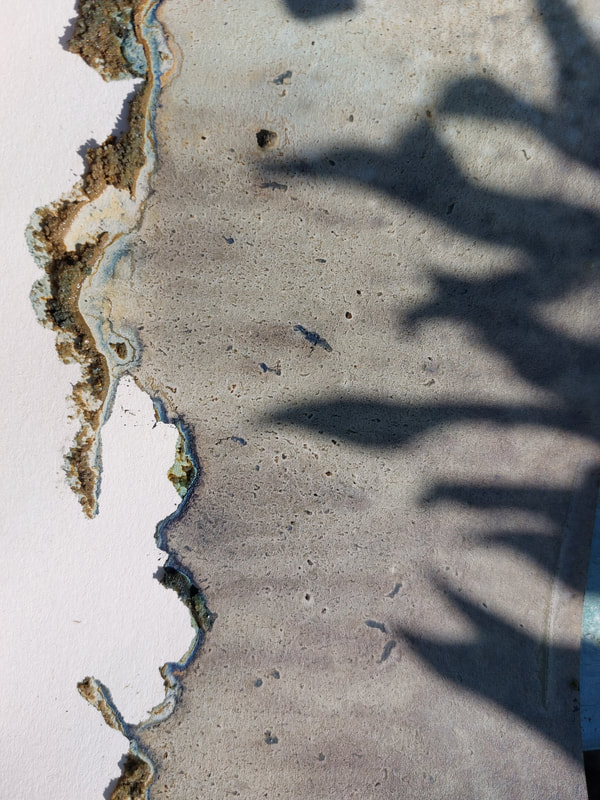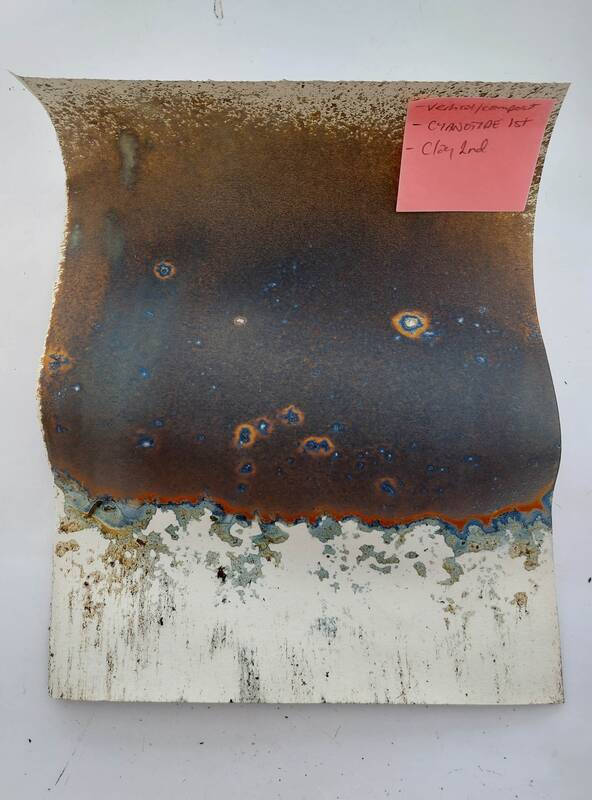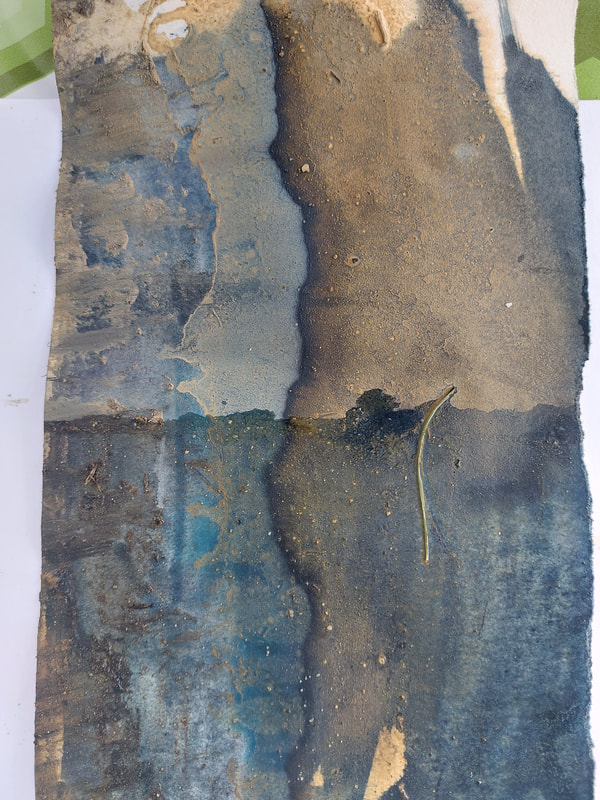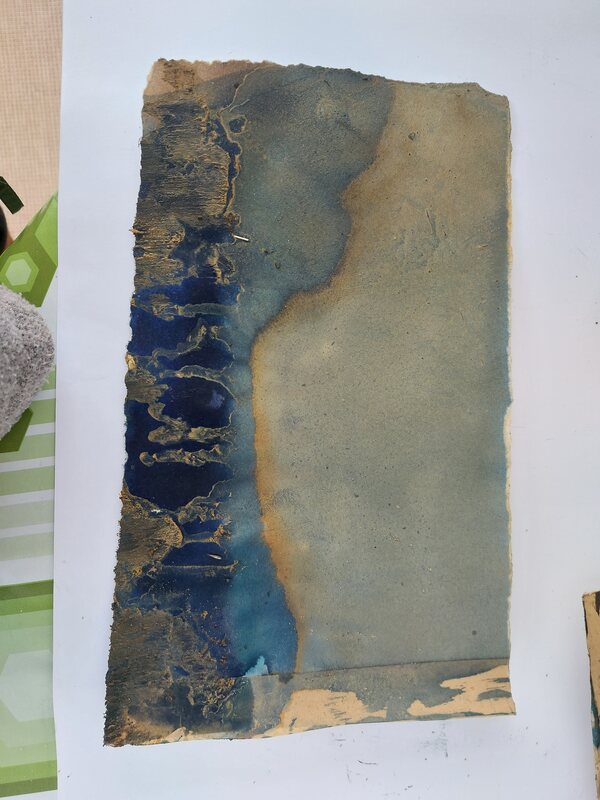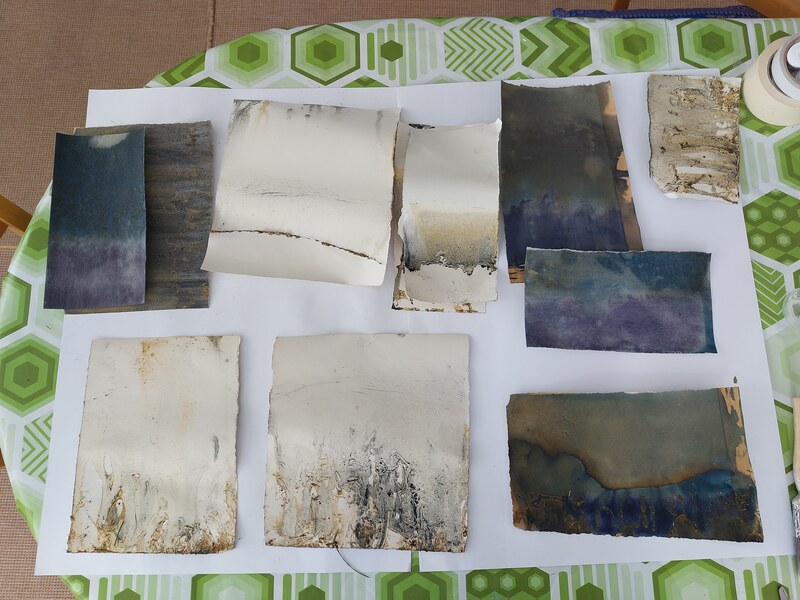|
I've been playing around with different gestural movements and working through circular actions. The circle form always rears its head within my work and although some of the initial marks realized aesthetically work, I do feel that these are too 'forced' and the process has not been left to chance and unpredicted moments; there is too much of me and my input in the work. My main concern for this body of work is to facilitate and for the elements and materials to produce!
The images above do show how the fluidity of water and liquids determine aesthetical outcomes and the need to encourage the connection of materials through moisture and the elements presented when working within a hypaethral environment is the important factor. I do find this repetitive process of application and degeneration depends so much on chance and the best marks that materialize are when the pieces are left to their own devices, with little interaction from myself. Minimal interaction from myself is, after all what I am trying to achieve. It is very tempting to observe the changes and happenings within the works and to interfere with how the materials are connecting. So after initial application I am teaching myself to walk away and to just let things happen!
0 Comments
So, I'm moving into a sequence of repetitive application of materials, stripping down (by the rain) and re-applying mediums (salt water, clay, charcoal, plaster, sand and a little cyanotype) onto canvas boards. The reasoning behind this process is to invite the elements to participate with the paintings and contribute to their degeneration. All the work is created outside and the elements at the time of making contribute to the visual and drying aspects of the work. A little cyanotype is applied which mixes with the other materials, reacts to the sunlight and creates blue and orange tones contributing to the overall imagery. I am conscious of using cyanotype and its chemical base, but I see this as a juxtaposition against the natural materials of clay, charcoal and plaster as with other organic work I have produced such as ice sculptures containing monofilament; it represents the invasive nature of modern-day pollution, climate change and technological intrusion.
Reminiscent of Turners landscape paintings so far, I'm finding the pieces have become very romantic in nature with much movement and likeness to volatile weather systems. Some of the works look great at the 'stripped down point' and some after the application of materials and I am now wondering at what point do you stop the process? The main aspect is the aesthetics and the goal to realize a perfect 'mark'. My exchange and dialogue with both the materials and the elements who contribute to the production of the works are now becoming a sequence of exchanges, recording, wiping away with only the strongest of marks remaining. Over time these boards will start to deteriorate which in itself this degradation becomes part of the narrative of presence and making. The aesthetics in the formation of alchemic moments and the remnants of degeneration and decay, are the key moments I am searching to preserve. Moving forward from last week I've started a cycle of making works on canvas board and presenting them back outside into the elements especially when there is rainfall. At this time of year rain is the main element that has the capability to break down the materials and strip away the matter on the boards. If we were in the winter period, there would have been plenty of invasive weather patterns to help the degrading of the marks, like snow, ice and heavier rainfall so I've got to be on my toes with the weather forecast and present the work outside as soon as rain is predicted!! The added advantage to this time of year is that the pieces dry out quicker so reworking can be done faster.
Initial marks can be really interesting and aesthetically work. There is a doubt as to whether they should be presented back into the elements but the whole reasoning behind this project is for the elements to make their mark and I need natures contribution to the drawings. The repetitive aspect of mark making and the presentation back into the elements to strip down mimics the constant that is nature, the cycle of growth and decay and the fluctuation of the seasons. The stripped back pieces (above last row) have a feel of decay and transience and the remnants of what once was, an ephemerality. Whether this is the point where I stop the repetitive process, I'm not sure at this stage. For me it's a matter of capturing the process at the moment of its most aesthetic perfection! We had a really interesting workshop this week with artist Lauren Saunders aurensaundersart.co.uk talking about her practice-based research methodologies and alternative ways of experiencing the word around us. A kind of holistic approach we did mindful activities, slowing the pace down with an emphasis on the senses rather than the visual aspect. With closed eyes, drawing the feel, texture, smell and taste of an edible object and the same with a piece from nature. It was a great exercise to see things from another level and one of the questions I particularly took away with me was ' If a piece from nature was talking to you, what would it say?' I'd never really looked at nature from this perspective in any depth but it's something I will be questioning from now on. The workshop did remind me of my connection to nature and my long association with the natural world in one form or another within my working life and how I apply certain ways of seeing every day in an instinctive and intuitive way. I'm lucky enough to be able to observe nature and how it informs us in its changing of the seasons through my 9-5 work, my garden and my embodiment of the Yorkshire landscape. Natures many changes I observe on a daily basis, the colour and smell of the landscape, the texture of plant life, the changing forms of growth from lush green to stark dark skeletal and the restfulness of decomposition in Winter before the cycle begins again in Spring all inform. Along with profound memories of childhood and interacting with the landscape, the textures and senses of water, stone, earth, wood, the wind on my face in the open fields and the water around my body while swimming in the rivers of the countryside are what fuel my making now. My present investigations to see what earths materials can make are, I suppose a need to return to the innocence and pure happiness of childhood? With the influence of Turners work I've started to work on the concept of expression and a more painterly free flowing application to try and convey the viscerality of the elements. It's important that my intervention is minimal, and the main aspect is to allow the materials to merge and react with each other and that the work be open to the elements. I experimented with minimal applications on paper to try and form a more translucent finish (see above). The key to this work is the application of water. The water facilitates the free-flowing action of the materials and allows them to merge and settle randomly and organically. I came across some old small works on canvas board that I'd neglected and forgotten which sparked a different way of working and spurred me on to examine the painterly aspect I'm exploring on this more robust surface. The two pieces have spent much of their time outside being stripped down by the elements over the winter period before I rescued them and brought inside to dry, I applied a small amount of sand & cyanotype to see what would happen and there were some really nice results (see above 2nd row down). The added aspect of canvas board means I am able to apply thicker materials such as plaster as the board can take the weight. Love the idea of the elements working into the works and then rescuing the pieces and reworking onto the surface. This aspect gives more depth and authenticity to the work and portrays a succession of reworking and intervention of the elements... the passage of time, and so a process I am going on to explore. We had a fabulous presentation by the artist Lydia Ourahmane . (lydiaourahmane.com) talking about her life changing final year at Goldsmiths and the coming together of her piece for the final show 'The Third Choir'. Originally born in Algeria and experiencing a humbled, commune like early childhood she sees her practice as a 'tool to understand the world around her'. Her journey so far as an artist very much reflects the strength and determination needed to achieve her thought provoking pieces. Stretching continents, challenging bureaucracy and the term 'it's not possible' has not deterred her as she uses her resourcefulness and craft of living life in an almost nomadic transient way to gather her art installations together. I was especially interested in her project of archiving family photos of her early childhood and the importance of preserving these memories and lived experiences. For me it reminds me of the contrast of how we record memories in the 21st century and how the manipulation of images to be 'perfect' do not record a true record of that moment in time. Pre digitalization we didn't have the means to manipulate or delete images, we just snapped away and took film to be developed, never knowing how the images would turn out. The outcome was always a surprise, with many images (at the time) being seen as not all that good but looking at these images in later years a truer representation of those moments was recorded. Real expressions, unplanned records of place with random furniture, people or belongings in the background, a more honest social record of those moments and the time was captured. When we look back at these images, we have a real sense of those moments and our wider lived experience. Me & my Dad 1965She also spoke about how her work would carry on and how it would be disseminated in 300years time. There is much use of technology within art works today video, film, photography etc; how would these works survive and be exhibited in another 300years. It's a question that's similar to the way I've been viewing my own work; the problem of ephemeral work and the need to always record this work through photography and film and why I'm concentrating on working through making more physical 2D painterly works. Much of this concept is centred around the need to leave something physical when I'm not around anymore, the ephemerality of our lives and necessity to leave my mark. I really connected to Lydia's work because of its portrayal of her own heritage and the concepts of presence, what we leave behind and how these objects and moments are viewed by others. All this resonates with my own work the passage of time, the marks we and the elements leave and the legacy we leave of our presence.
I've been working through ways of executing more 'painterly' work and concentrating on aspects of expression; throwing materials onto the paper in a looser flowing action and allowing materials to react and blend with each other. The previous experiments threw up some lovely organic markings that resonated lots of movement but I'm not too keen on the garish in your face aspect of the work and want to create a more subtle expression similar to the work above.
I've been really interested in JMW Turners work recently after watching the BBC programme 'Art That Made Us'. Turner is one of Olafur Eliasson's greatest influences and an interesting thing he said in relation to Turner's work was that '.... Turner paints what we cannot see' This concept is something I'm striving to realise in my work. Reading the book 'How Turner Paints' he had an ability to express the environments he inhabited with such visceral effect capturing the huge shift in society happening within the early 19th Century and the Industrial Revolution. Turner could see the effect this change was having on our planet and our way of life. He expressed this change from a slower pace of life to the aggressive fast-moving impact of industrialization through his paintings capturing the atmosphere of the time and the places he inhabited. He was the first Environmental Artist! Within this air of change his own way of working differently seems relevant. Experimenting with not always traditional painting materials, using what was to hand, thinking outside the box, throwing himself into his work physically and mentally reflects the huge times of change around him. It all strikes a chord with me and how he was able to create such visceral atmospheres within his paintings. It all seems relevant to what we are living through today; the consequences Turner was warning us about, pandemic, climate change, war......... We had a session with the performance artist Jamal Gerald this week. He pushed us into different ways of thinking about our work in a more sensory aspect asking us lots of questions which allowed us to think of different ways of expressing our work. The questions below are a snippet of what he challenged us with but some I'm going to answer briefly here as they define my practice and ways of working: What do I want to say and why? I want to portray the fragility and beauty of life with the use of the most basic of materials from the lands I inhabit in order to make the viewer look at the world around them differently and respectfully. What am I making and why? I am exploring paper- based drawing/paintings using materials sourced from the places I inhabit to feed my need to create works of literal mark making as opposed to ephemeral works that rely on photography to record their existence. What do I want my audience to take away? I want the audience to connect to the work on an aesthetic level, to wonder how it was made, to realize the importance of expression and influence others. Do I care? Yes, both positive and negative responses still mean the work has connected to someone! After the positive experience with salt water and sand I've been experimenting back in the outdoors at home. First applications were very random with no real prejudgement of where the materials were going to be placed which brought out some striking celestial type marks. Reflecting back on aspects of Rothko's rectangular work smaller linear experiments were explored with more ordered and precise applications of materials which again made some beautiful markings and textures.
I feel I need to make this work on a large scale, so the viewer is smaller than the work, to try and emulate the vastness of open landscapes and how small we are within it. I took a trip to the East coast to the lovely town of Filey the other day to experiment in the landscape of the fabulous beach they have there. The sand is particularly fine and the beach vast when the tide is out. It's always the same question when you arrive at the coast 'is the tide coming in or out?' well it was slowly coming in.
The weather had been very unpredictable driving in, the atmosphere was warm and mixed with the earlier downpours a rolling low mist had formed over the beach. With this slight edge to the weather and the strong spring tide some of the early experiments in the sea meant I got a bit wet, but this was an excuse to take my socks and boots off and get right into the sea and feel the sand between my toes! Playing around with the sea water, sand and cyanotype on paper and burying paper threw up some interesting colours and textures, the salt water and sand had a great effect on the cyanotype creating some rich rusty orange tones. I'm trying to use as little cyanotype as possible and use it in a more immediate and painterly way instead of the traditional way of coating paper and drying pre-exposure. Its more about using the liquid as a vehicle for interaction with other materials and the light & atmosphere. I've noticed a similar likeness to Rothko's floating rectangle work in the recent pieces I've been experimenting with. I love his ability to create aesthetics that are moody and atmospheric. They remind me of climatical shifts and changes. I also love the restricted aspects and the way the aligned and vertical shapes portray a likeness to the definitions of open spaces, His reference to vast spaces, the sublime and aspects of a 'limitless immensity' resonates with me and the vast spaces of the landscape in which I place myself within and inhabit (if only for a short time)
His way of exhibiting is also interesting and the way he hung these works at a low eye level so the viewer could be more intimate with the work. This is something I definitely need to take into consideration when exhibiting as I really want the viewer to get close to any work I produce and hone in on details as well as see the work in its entirety from a distance. After my first session as Visiting Research Associate at LAU I was left with many questions about my identity as an artist and how i portray myself and justify what I do. One of the questions I was confronted with was ' What identifies me as an Environmental Artist?' which has brought to light my own constant questioning about how I justify myself as an 'Environmental Artist' under the impossible legacies left by the original Environmental & Land Artists of the '70s. These artists physically connected to the land in (how I see) monumental ways, carving out the land, creating large land art using the materials of the land. However, I do feel Environmental artists of the 21st Century work within a different context and manifest themselves in different forms. I've always been very focused on the act of restricting my materials to only organic matter, which is limiting, but I always feel that I am being authentic and true to myself, but maybe it's time to reassess and change my approach? I've worked within the flower & horticultural industry for over 30 years and grew up within the countryside experiencing making and playing within a rural setting on top of my work ethic within my practice, so I do feel qualified to be able to call myself an Environmental Artist, but my ethical approach does leave me limited at times.
Practically wise I've been exploring the properties of cyanotype further combining clay and charcoal as painting mediums and aspects of burying sheets of paper in the ground, the space below ground level, ground level itself and the space above. There have been some great painterly type results with beautiful fine lines of clay deposits. The blocks of colour presenting themselves on portrait positioned sheets of paper have really caught my eye reminiscent of Rothko's rectangular paintings. Recording particles created by the elements on paper is a time-consuming process that takes months even years as can be seen with Stephen Turners 'Tree Rings' consequently I've been thinking of ways to facilitate faster responses to elemental mark making.
After seeing an image from an Instagram post by @margaretsoraya; a photographer based in the Isle of Harris, I started to look at my project #disjointedhorizons from a different perspective. Margaret had taken a particular image submerged in the ocean, with the snowy mountains in the distance and the sea in the foreground, this linear/horizontal close view of the water soften the image and portrayed the view as if swimming in the sea and the water enveloping around you. The stunning image got me thinking about viewing the earth from a different perspective.; instead of always viewing work and making from above, as is often the case with Google Earth and images from space, this horizontal position feels like a new way of observing and making. . I've always been fascinated by the act of digging into the earth and the enormity of carving out the land for both construction and quarrying earth's resources. Working on a horizontal level, going down into the earth below the borderline of ground level presents some new challenges and ways of working. After visiting my good friends exhibition (click Here -) Nunnington Hall opens for 2022 with a new exhibition - Castles Gardens (castlesandgardens.co.uk) I started to revisit the light sensitive process of cyanotype and the process of placing paper within cut out openings in the ground to enable a juxtaposition between the above, the below and the broken 'crust' of the earth. Cyanotype for me can be very restrictive as far as always being blue tones but by using materials unconventionally i.e. mixing with earth pigments such as clay, charcoal and rust and allowing the earth and detritus to connect with the paper there have some surprising results. Using the cyanotype more as a painting medium at the point of experiment rather than prepping paper before hand which is traditionally done has helped me push the process further. There's no getting away from the fact that cyanotype is a great light sensitive medium that can interact with the elements and produce some great marks and drawings but I want to work through ways of making the cyanotype a less dominant feature in the work. |
|
